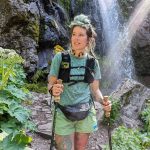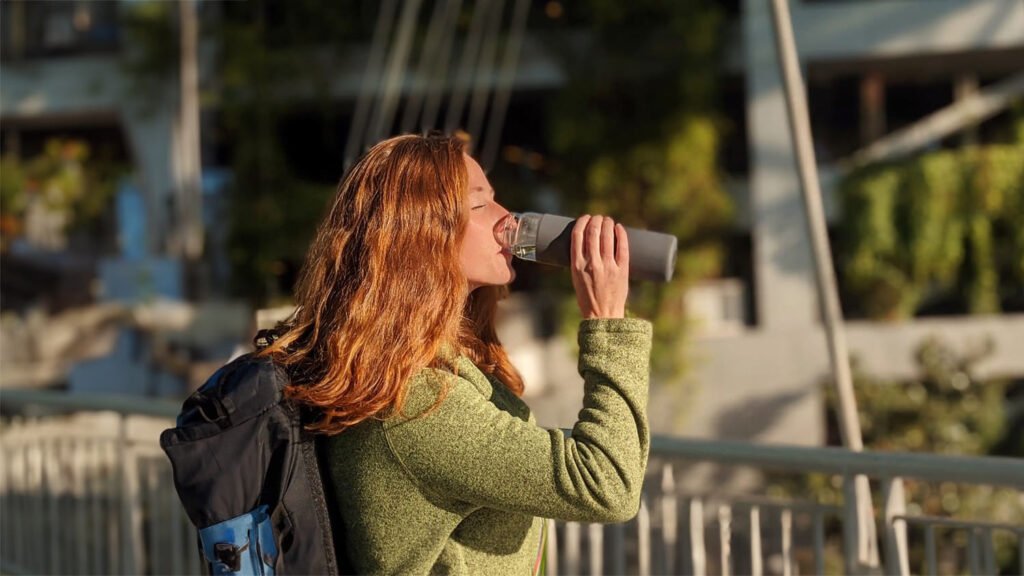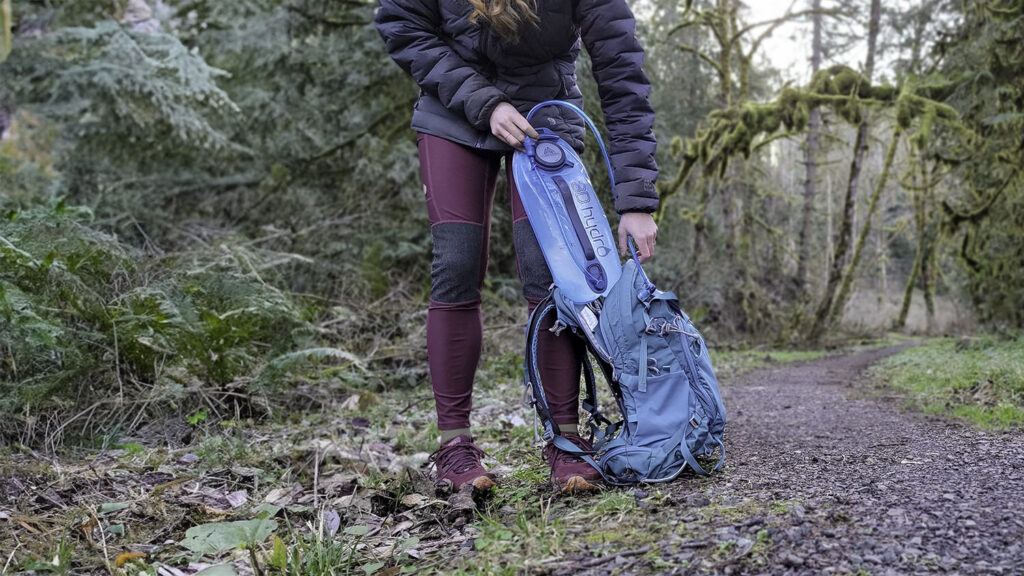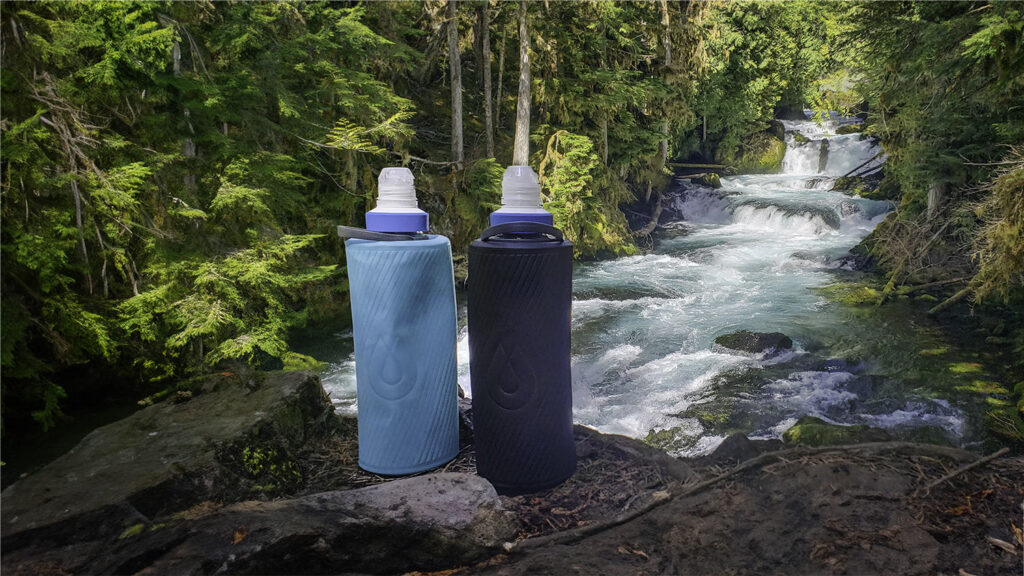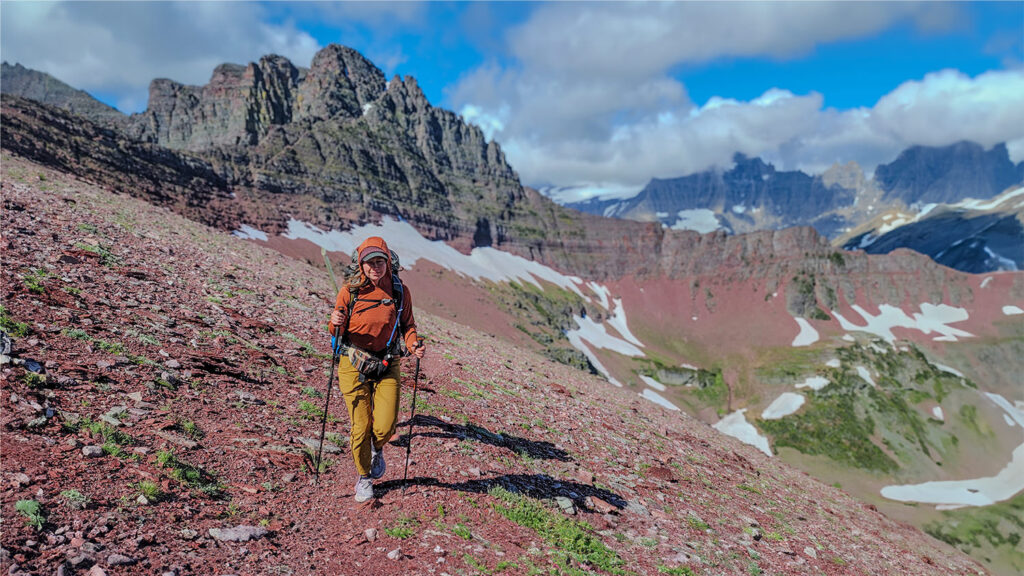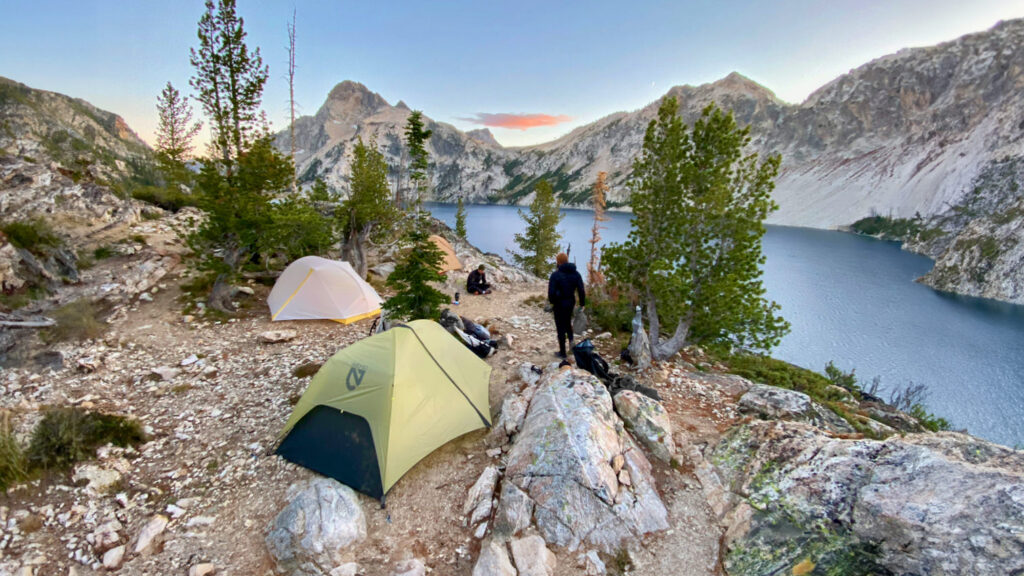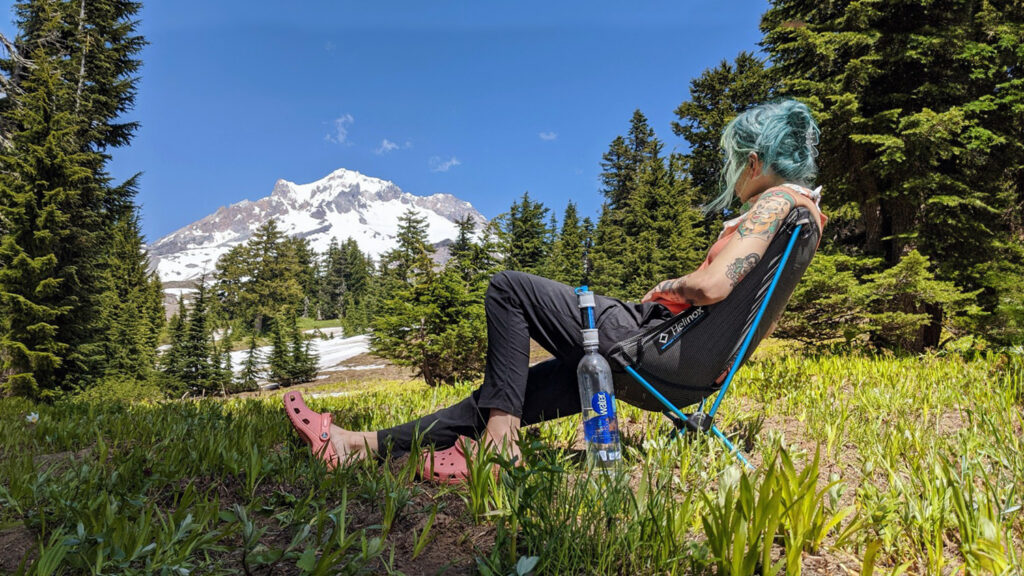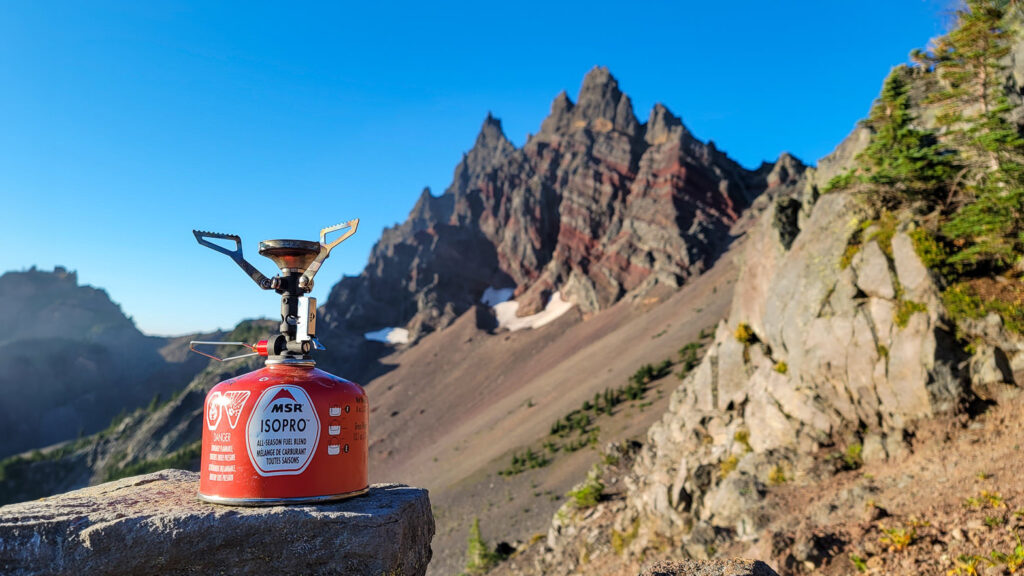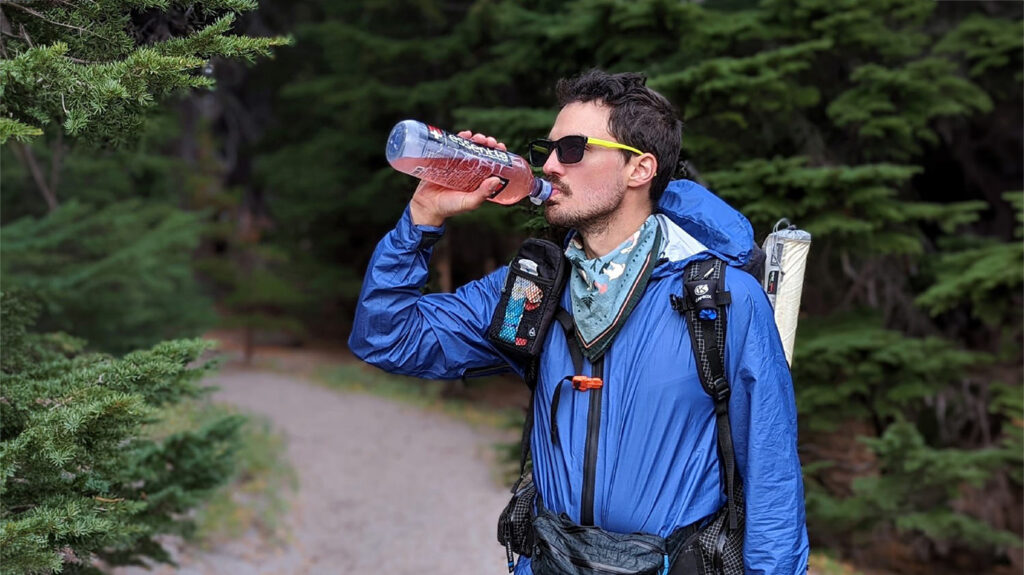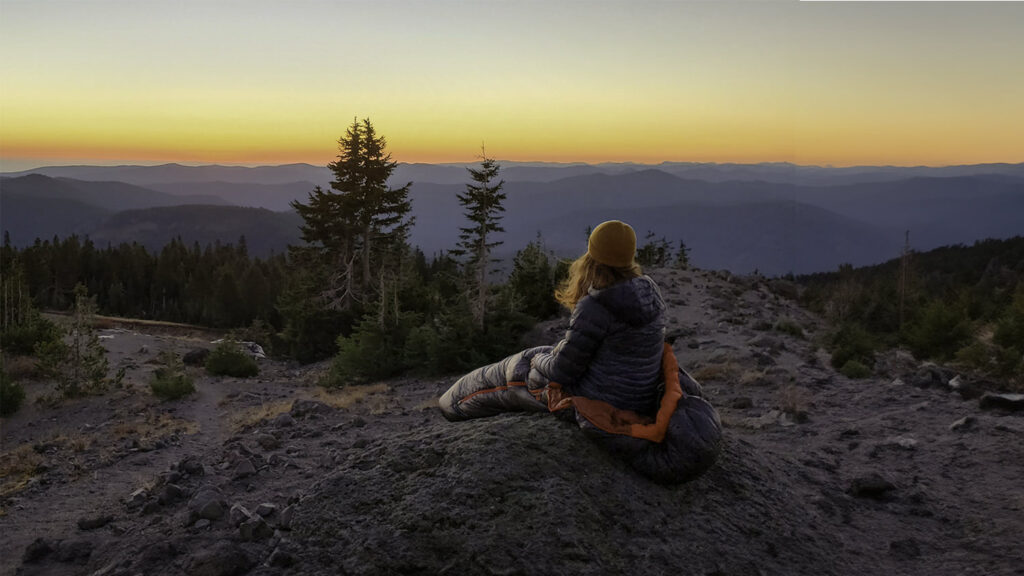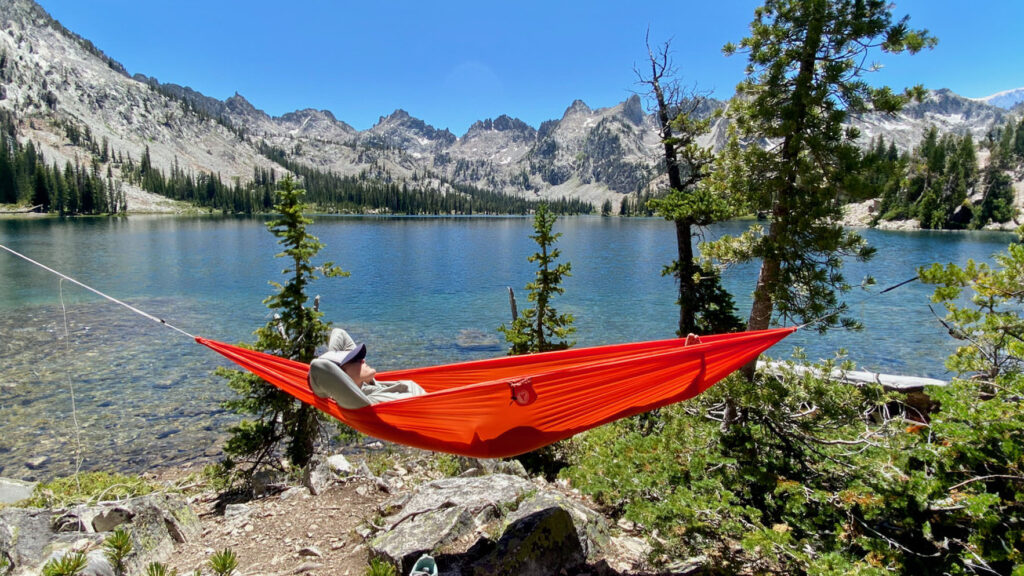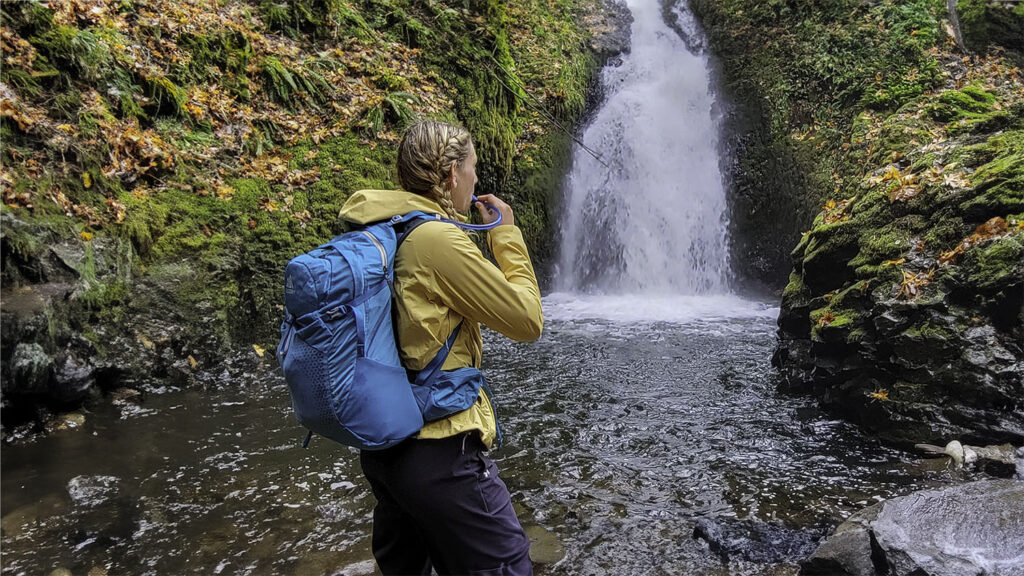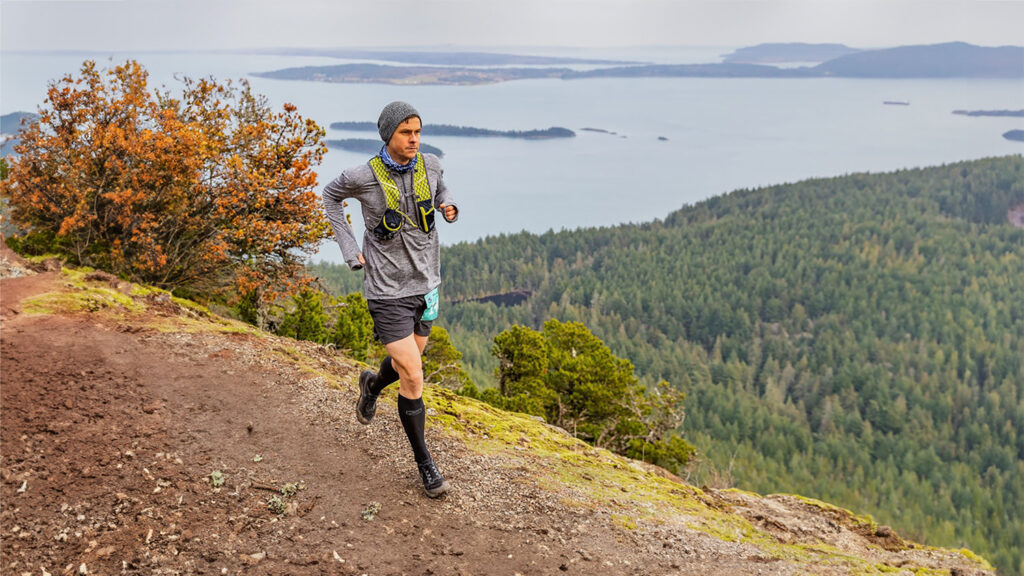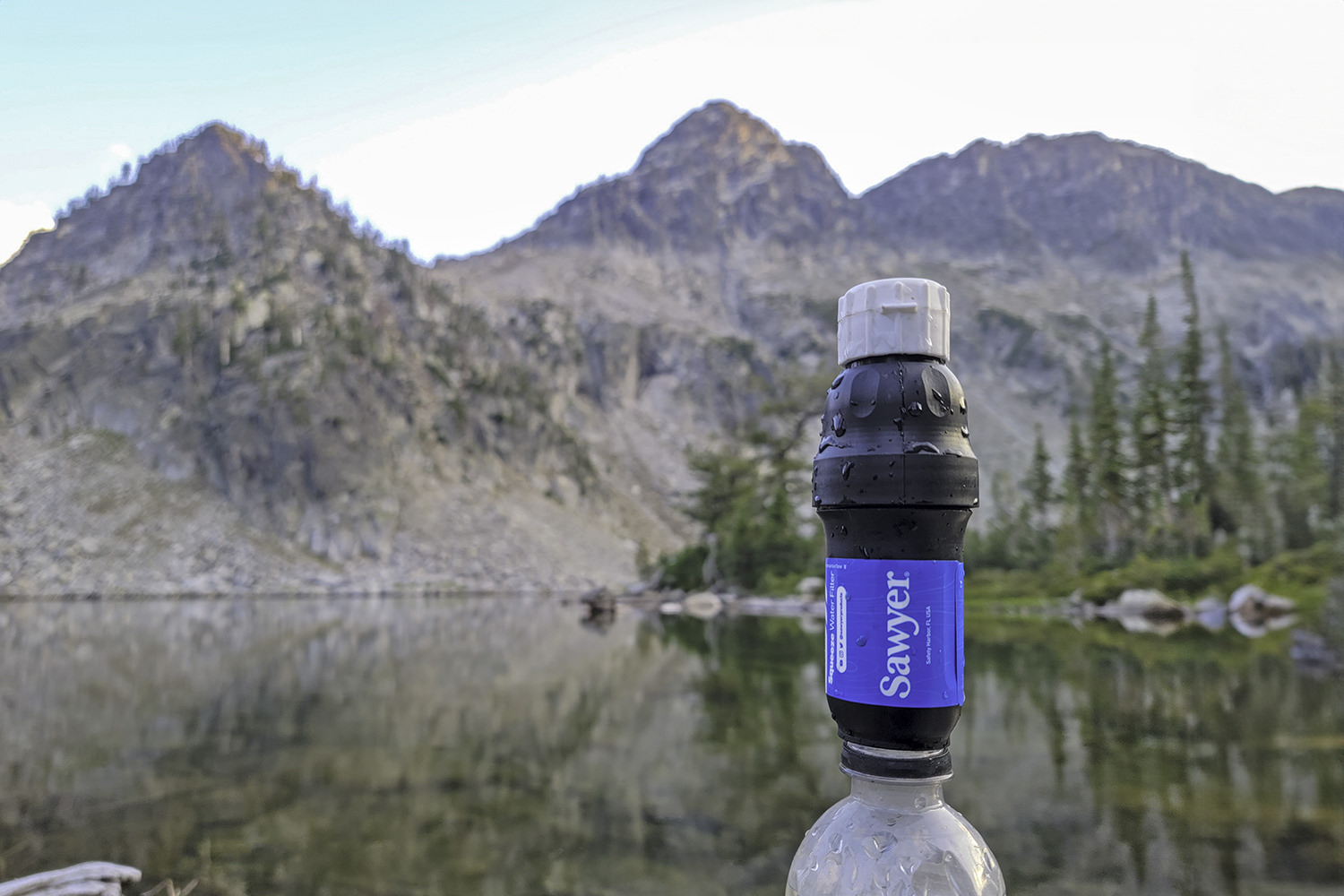
We’ve used just about every type of filtration and purification method available in our 20,000 miles of hiking over the past decade. From brands like Sawyer, Katadyn, Platypus, Aquamira, and more, we tested for water quality, maintenance and longevity, treatment time, weight and packability, and ease of use. Whether you’re looking for ultralight filtration for your next big adventure or a reliable purifier for overseas travel, our team of experts will help you find the perfect water treatment for your needs.
And for more info, check out some of our other popular gear guides:
Quick Picks for Water Filters
Check out this quick list of our favorite water filters, or continue scrolling to see our full list with in-depth reviews.
Best Water Filter Overall: Sawyer Squeeze ($41)
Best Ultralight Water Filter: Katadyn BeFree ($45)
Best Gravity Water Filter for Group Camping & Backpacking: Platypus GravityWorks ($135)
Best Chemical Water Purification: Katadyn Micropur Tablets ($16)
Durable Squeeze Filter with a High-Quality Reservoir: Platypus QuickDraw ($55)
Best Budget Water Filter: Sawyer Mini ($25)
Best Pump Water Filter: Katadyn Hiker ($90)
Best Chlorine-Dioxide Drop Purification: Aquamira ($15)
Best Filter for Purifying the Worst of the Worst Water: MSR Guardian ($390)
Best UV Light Water Purifier: Katadyn Steripen Ultra ($130)
Lightweight Filter that Works Well in Shallow Water Sources: MSR Trail Shot ($63)
What’s new
We consistently switch up which water filtration method we take on our backpacking trips so we can compare our old favorites against new products. We’ve added some new reviews with long-term testing results:
- We’ve added full reviews of the most popular chemical water treatments. Check out our review of Katadyn Micropur Tabs here and Aquamira Drops here.
- We published a full review of the Platypus Quickdraw.
- There’s now a full review of the Platypus Gravityworks.
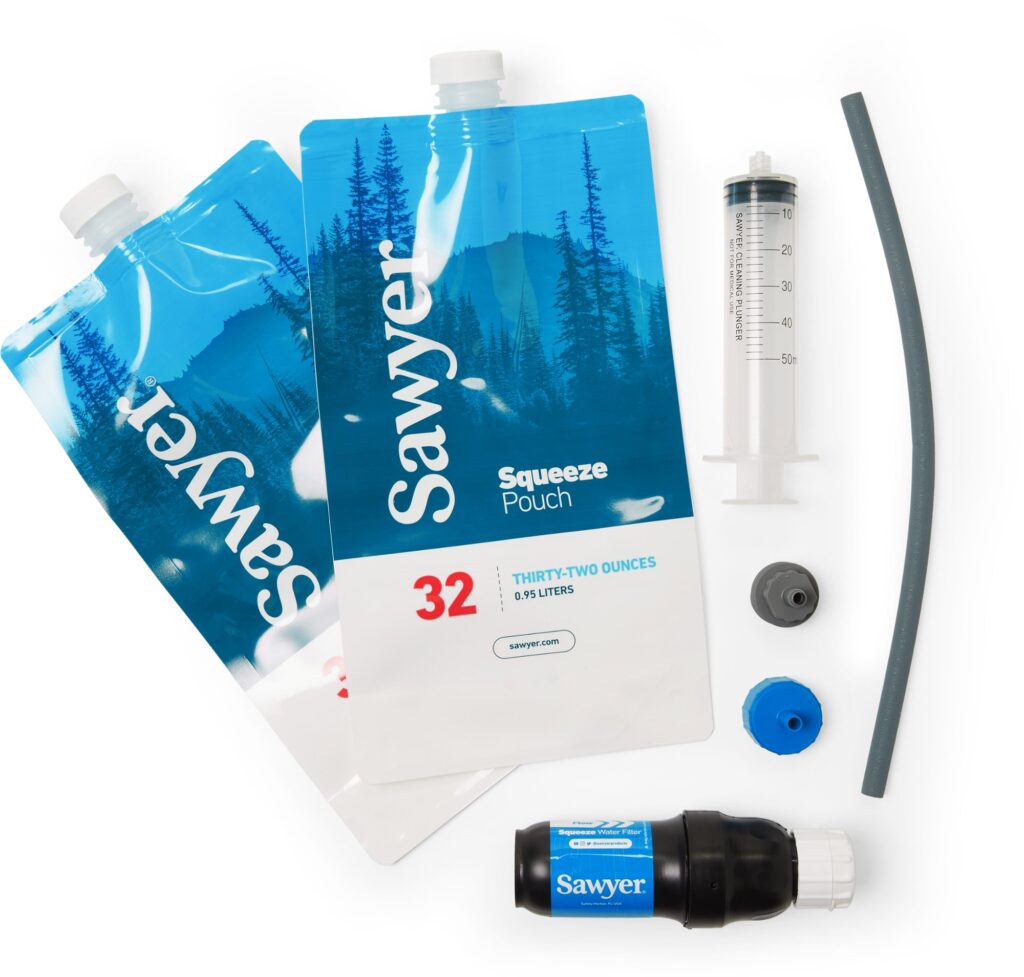
Sawyer Squeeze
Best Water Filter Overall
Price: $41
Weight: 3 oz.(including a 32 fl. oz. pouch)
Flow Rate: 1.7 L/min
Filter Pore Size: .1 microns
Lifetime Volume: 378,000 L
Pros
- Ultralight
- Compact
- Less expensive
- Easy to use
- Great flow rate
- Fits a variety of bottels
Cons
- Included pouches aren't durable
- Requires syringe to backflush
We’ve trusted the Sawyer Squeeze to filter our water on more than 8,000 miles of our backpacking trips – including a thru-hike of the Continental Divide Trail as well as multiple thru-hikes of the PCT – because it’s one of the lightest options available, it has a fast flow rate, and it’s so easy to use.
This filter pairs with a variety of vessels, but we typically use the Squeeze with an inexpensive Smartwater bottle because it makes for an ultralight and decently durable water filtration system. We’ll often drink straight from the sport cap on the Squeeze to cut out the step of filtering into a different bottle. Keep in mind that you’ll still need an extra bottle to squeeze clean water into if you want to use hydration mixes or other water supplements since you don’t want that stuff to go through your filter.
One of the primary downsides is that the flow rate can slow down over time – especially if you encounter a lot of silty sources. It’s a good idea to use the included syringe to backflush your filter every so often to extend its life and keep it flowing fast. For multi-week hikes on long-distance trails, we’ve had good luck finding one of the Sawyer syringes at hostels or in hiker boxes to use during town stops.
We’ve kept multiple Squeeze filters going for several thousand miles by keeping the hollow-fiber membrane protected in freezing temperatures (just tuck it in your sleeping bag on especially cold nights) and backflushing regularly, so this is a great investment for hikers on a budget.
The pouches that come with the Squeeze can wear down relatively quickly, so you should carry a replacement if you choose to use the included squeeze bags instead (the filter comes with two).
Sawyer also makes this filter in the smaller, lighter Mini (below) and Micro versions. These are both lighter than the original we typically use. While we love shaving ounces from our pack weight when possible, we recommend going with the standard Squeeze for its faster flow rate. The Micro and Mini aren’t bad options, but they clog a lot easier than the Squeeze.
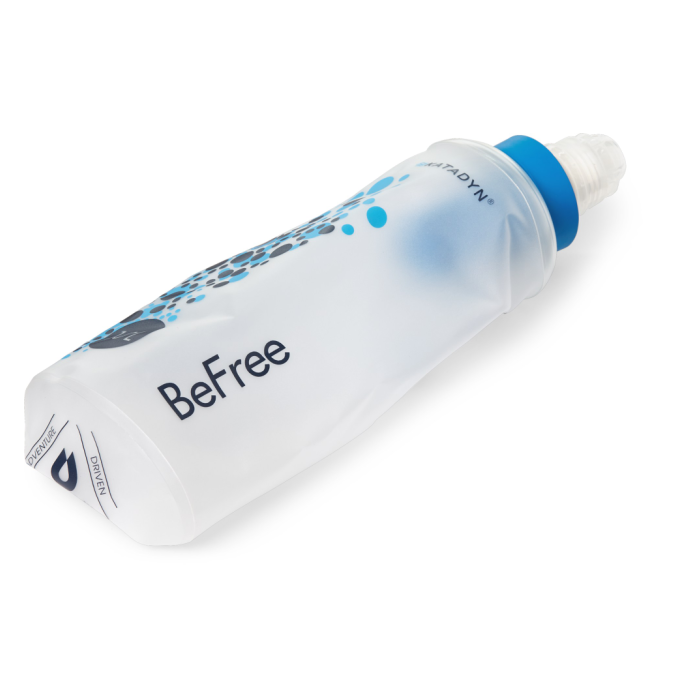
Katadyn BeFree
Best Ultralight Water Filter
Price: $45
Weight: 2.3 oz.(including 1 L soft bottle)
Flow Rate: 2 L/min
Filter Pore Size: .1 microns
Lifetime Volume: 1000 L
Pros
- Less expensive
- Excellent flow rate
- Ultralight
- Compact
- Easy to clean in the field
- Easy to use
Cons
- Limited bottle compatibility
- Clogs easily
The Katadyn BeFree is an affordable, ultralight water filter that has an incredible flow rate for how small it is. You can drink directly from this filter while you’re on the go thanks to its sports bottle-style top.
CleverHiker Senior Gear Analyst, Casey Handley, has used this filter for more than 2,000 miles of backpacking – including her hikes on the Long Trail and Arizona Trail. She has a slight preference for the Katadyn over the Sawyer Squeeze since the BeFree is easier to clean on trail without having to carry extra components. It’s also a bit lighter and the flow rate is faster.
To clean the BeFree in the backcountry, you only need a clear water source to dip water from. Fill your vessel about halfway full, screw the filter on, then shake it vigorously for a couple of minutes. Dump the water out – as it will have collected lodged debris from the filter element – and now you’re ready to filter again with a restored flow rate. This is one of our favorite features of the BeFree since it’s so easy to get it working like new again.
That said, the BeFree does have a tendency to clog a little easier than the Squeeze, and some hikers may find this loss of flow rate and the steady need to clean it to be a pain in the butt.
While the soft bottle that comes with the BeFree is pretty durable, we like to pair this filter with the more versatile Hydrapak Flux soft water bottle. We prefer the Flux because it has a handle that makes it a bit easier to gather water, a flat bottom that allows it to sit upright, and more durable, thicker material. If you choose to go this route, we recommend buying the replacement filter only – which doesn’t include the BeFree bottle – to save some money.
Ultralight backpackers seeking the best combination of weight and flow rate are sure to love the Katadyn BeFree.
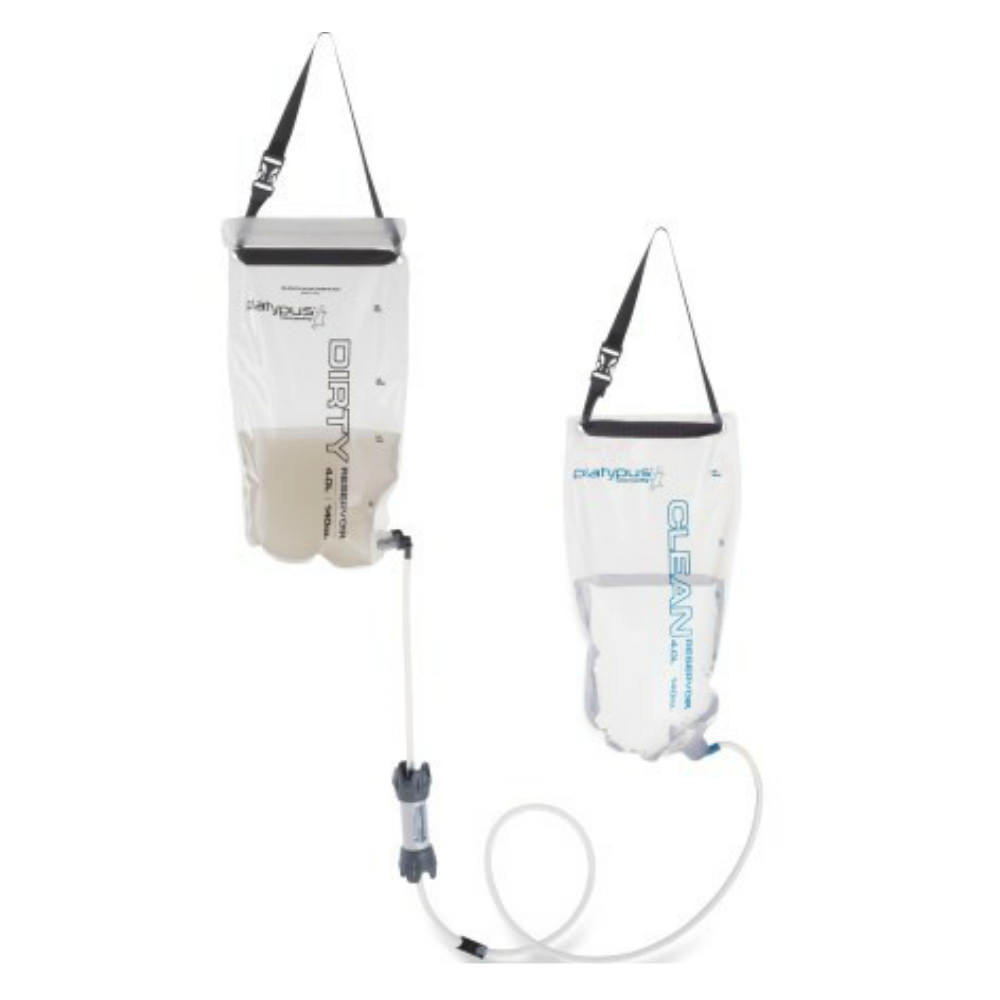
Platypus GravityWorks
Best Gravity Water Filter for Group Camping & Backpacking
Price: $135
Weight: 11.5 oz.(including 4 L reservoirs)
Flow Rate: 1.75 L/min
Filter Pore Size: .2 microns
Lifetime Volume: 1500 L
Pros
- Very easy to use
- Convenient for pairs & groups
- Good flow rate
- Can filter a large amount of water at once
- Easy to clean in the field
Cons
- Heavy
- Bulky
- Expensive
- Slows down over time
The convenience of the Platypus GravityWorks is tough to beat, especially for pairs or groups. To use the GravityWorks, simply fill up the “dirty” water bag, hang it above the “clean” bag, and let gravity do its thing.
The main benefit? No tedious pumping or squeezing is required. This is especially handy for groups since filtering multiple liters of water at once can be pretty time-consuming. CleverHiker Gear Analyst, Heather Eldridge, opted for the GravityWorks when she took five of her family members backpacking in Oregon’s Eagle Cap Wilderness. This allowed the group to spend less time filtering and more time hiking and building memories together!
The GravityWorks is heavier than most of the other options on our list, so it’s not our first choice for solo trips. But when you can share the weight with a partner, it’s not too bad and could be well worth trading the weight for ease of use.
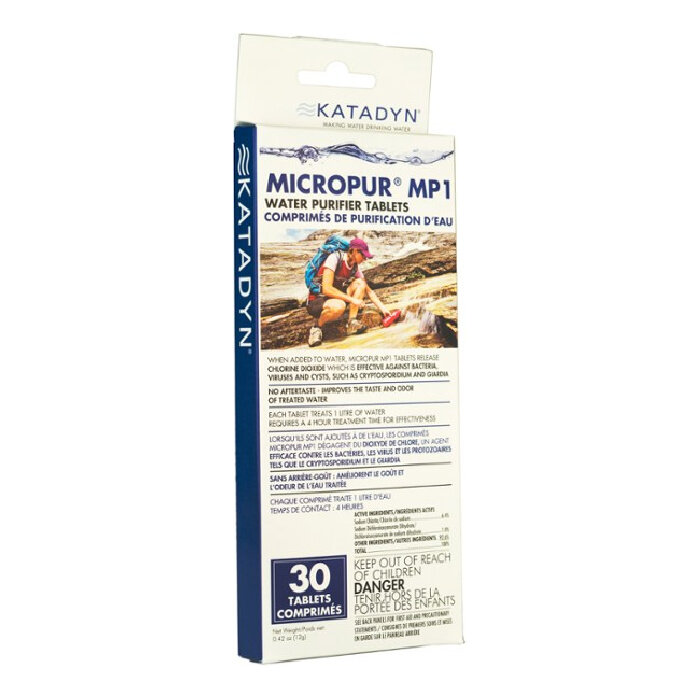
Katadyn Micropur
Best Chemical Water Purification
Price: $16
Weight: .9 oz.(30 tablets)
Flow Rate: N/A
Filter Pore Size: N/A
Lifetime Volume: 30 L
Pros
- Ultralight
- Compact
- Easy to use
- Affordable
- Kills viruses
- Can't break
Cons
- Wait time necessary
- Affects taste of water
Katadyn’s Micropur tabs are our top choice for those who want the lightest possible method of water purification, are in areas with a lot of livestock, or for use as a backup if a filter fails.
The active ingredient in these tablets is chlorine dioxide, which will eliminate the risks posed by microorganisms, bacteria, cysts (giardia and cryptosporidium), and viruses. We never hit the trail in areas with heavy agricultural use without packing a few of these since contamination from cattle and human waste are some of the most common ways waterborne illness spreads.
That’s why CleverHiker’s Senior Editor, Casey Handley, used Micropur tabs as her main means of water treatment on her 500-mile Colorado Trail thru-hike. This trail passes through a ton of pastureland, and many of the water sources are shared with cattle. But she had a worry-free hike thanks to the reliability of these tablets.
The biggest thing to keep in mind with this treatment method is that it requires a short wait time to work properly. You’ll need to let the tabs do their magic for a minimum of 15 minutes before your water is good to go. But you’ll have to wait a full four hours for the chemical to kill cryptosporidium – a fairly rare parasite – in areas where water is heavily contaminated with feces.
Luckily, microfilters – like the Sawyer Squeeze and Katadyn BeFree – can filter out crypto, so it could be worth it to bring both means of water treatment on trails with questionable water to eliminate the really long wait.
We love this treatment method because it’s affordable, easy to use, and nearly hassle-free. There’s a slight swimming pool taste with chlorine dioxide so we recommend throwing a packet of hydration mix in if that bothers you.
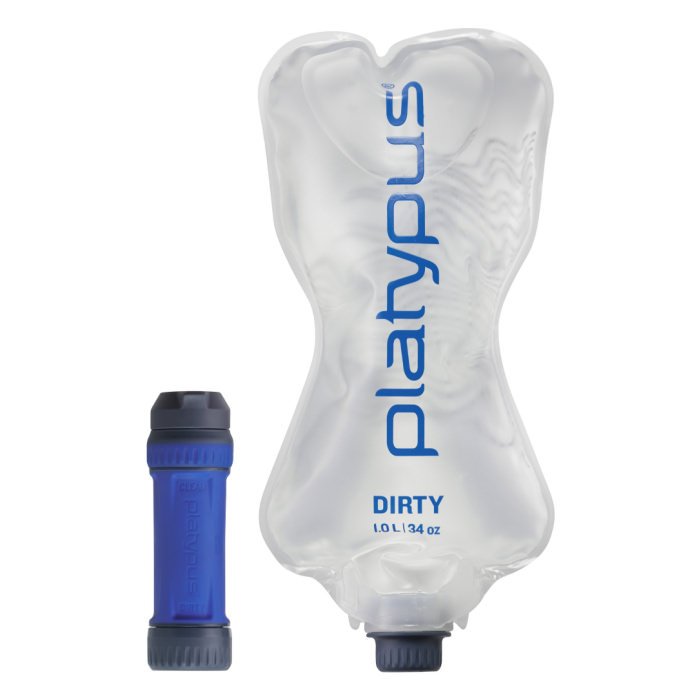
Platypus QuickDraw
Durable Squeeze Filter with a High-Quality Reservoir
Price: $55
Weight: 3.6 oz.(including 1 L reservoir)
Flow Rate: 3 L/min
Filter Pore Size: .2 microns
Lifetime Volume: 1000 L
Pros
- Excellent flow rate
- Lightweight
- Compact
- Easy to use
- Durable filter & reservoir
- Fits a variety of bottles
Cons
- Heavier & bulkier than other microfilters
- Slows down over time
The Platypus QuickDraw MicroFilter System is more durable and has a faster flow rate than other squeeze filters on the market, so it’s a great choice for thru-hikers or anyone who’s tough on gear.
The reservoir that comes with the QuickDraw is sturdy and has a convenient handle that makes filling it easy. It’s a significant step up in quality from the reservoirs included with the Sawyer Squeeze and Katadyn BeFree. The filter cartridge is threaded to fit a variety of water vessels, so you can also use the QuickDraw with a Smartwater bottle if you prefer.
The QuickDraw’s flow rate is excellent and very slightly faster than the leading competition. While Platypus’s three liters per minute claim feels like a stretch to us – save for maybe the very first use out of the package with a clean water source – we’re still happy with this filter’s performance. We timed it on a testing trip in Glacier National Park and found that we can squeeze one liter of water from the average source in about 40 seconds.
The QuickDraw is slightly heavier than the Sawyer Squeeze and Katadyn BeFree, which we view as a minor downside. But its tough build, fast flow rate, and premium reservoir help make up for the small weight increase. Overall, the QuickDraw is an excellent filtration option for hikers looking to go light.
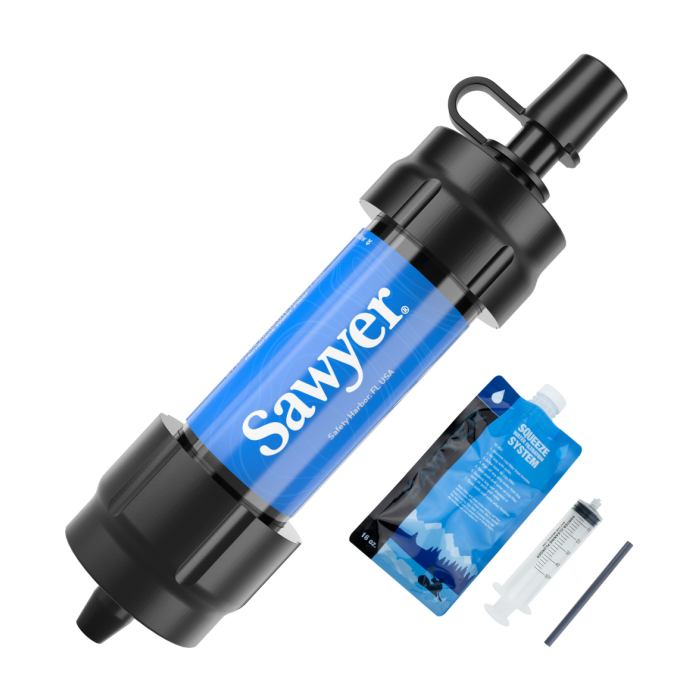
Sawyer Mini Water Filter
Best Budget Water Filter
Price: $25
Weight: 2 oz.(including a 32 fl. oz. pouch)
Flow Rate: 1 L/min
Filter Pore Size: .1 microns
Lifetime Volume: 378,000 L
Pros
- Affordable
- Ultralight
- Compact
- Easy to use
- Fits a variety of bottles
Cons
- Included pouches lack durability
- Slower flow rate
- Clogs easily
- Requires syringe to backflush
The Sawyer Mini is one of the lightest and most affordable water filters available so it’s a good option for beginners and minimalists.
To sweeten the deal, this filter comes with everything you need to hit the trail – a squeeze pouch, a cleaning syringe, and a straw that allows you to use it with wide-mouth bottles. However, the included pouch isn’t the most durable so we usually opt to swap it out for a Smartwater bottle.
The Mini is best for short trips with relatively clear water sources since it’s prone to clogging when used in silty sources. Debris-laden water will slow down its already below-average flow rate, so you’ll want to be able to backflush it regularly to keep it performing at its peak.
That said, the Mini is easy to use, compact, and will last a long time if cleaned regularly, so this filter is a really good investment for hikers wanting to go light on the cheap.
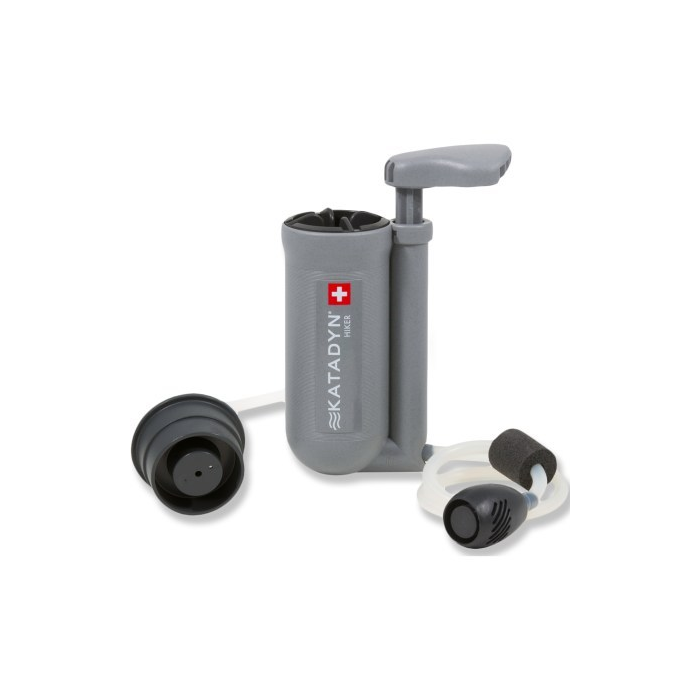
Katadyn Hiker
Best Pump Water Filter
Price: $90
Weight: 11 oz.
Flow Rate: 1 L/min
Filter Pore Size: .2 microns
Lifetime Volume: 1100 L
Pros
- Very durable
- Works in shallow sources
- Replaceable filter element lasts a really long time
- Easy to use if kept clean
Cons
- Heavy/bulky
- Expensive
- Becomes hard to pump after heavy use
- More involved cleaning process
Hand pump filters, like the Katadyn Hiker, used to be all the rage on backcountry trails, but they’re becoming less and less common these days. Still, there are some specific use cases where this tried-and-true design far outperforms the ultralight filters of the modern age.
The glaring shortcoming of most other filtration types is that it can be a struggle to get clean water from really shallow sources. You either have to fashion a scoop or filter water a tiny bit at a time – either way, it’s pretty time-consuming. The inlet side of the Katadyn Hiker is designed to be able to pull water from any depth, so it makes quick and easy work of filtering small puddles and the like.
The other big advantage of the Hiker is its longevity. While it’s one of the more expensive filters on our list, it has some clever design features that make it a worthwhile investment for those looking for something that will last for years. The inlet side has a pre-filter that sifts out large debris to help keep the main filter element clean. When you’re home from your trip, the whole thing can be opened up and each piece can be rinsed individually to remove built-up dirt.
The durability of this filter is the reason CleverHiker Senior Gear Analyst, Casey Handley, chose it for her very first thru-hike on the Appalachian Trail. The sturdy housing can withstand a lot of hard use, and the filter element can be replaced for less than the cost of buying a whole new Hiker filter once it’s met its end.
Though the weight and bulk of this filter may deter lightweight hikers, backpackers seeking the best durability bang for their buck won’t find a better option.
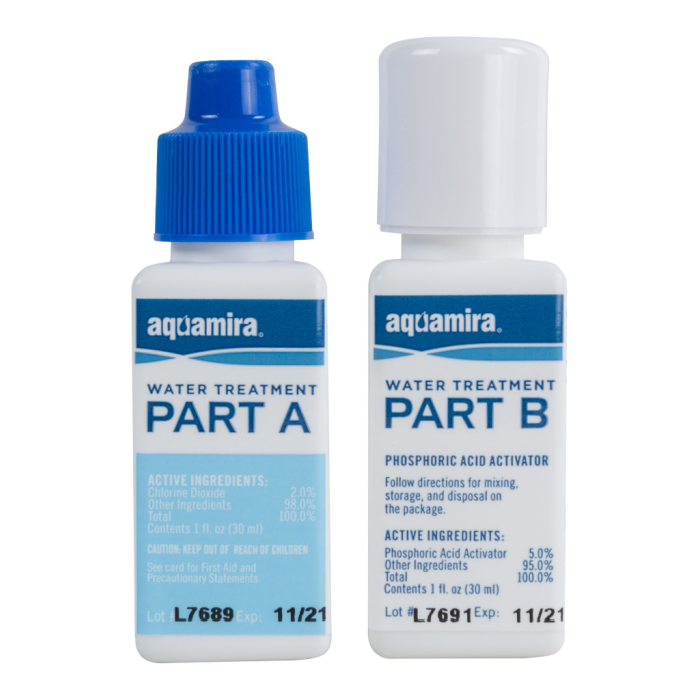
Aquamira
Best Chlorine-Dioxide Drop Purification
Price: $15
Weight: 3 oz.
Flow Rate: N/A
Filter Pore Size: N/A
Lifetime Volume: 114 L
Pros
- Ultralight
- Compact
- Easy to use
- Affordable
- Kills viruses
- Can't break
Cons
- Wait time necessary
- Affects taste of water
Like the Katadyn Micropur tabs above, Aquamira is a chlorine dioxide treatment that purifies your water of any harmful microorganisms, bacteria, cysts (giardia and cryptosporidium), and viruses.
We prefer Micropur over Aquamira, but this liquid form does have some advantages over the tabs – the biggest pro being cost per use. Micropur costs about $0.53 per liter whereas Aquamira costs around $0.13, so the savings is significant over time. The other glaring difference is the taste of the water after treatment. While both forms of chlorine dioxide can leave a chemical taste behind, the pool water flavor was far less noticeable with Aquamira.
That all sounds pretty good, so why do we prefer Micropur? It really comes down to weight and convenience. Since we’re often carrying chemical treatment as a precaution, we like the fact that we can bring only the amount of tablets we need for a trip instead of having to bring all three ounces of the drops. The tabs are also more convenient – you open the package, throw one in your water, and wait the appropriate amount of time. Aquamira requires you to mix drops from the two bottles, let that sit, then put it in your water and wait again for it to work.
Ultimately, both chemical purification methods will get the job done, and you should base your decision on what’s most important to you. If you want to maximize savings per treatment, go with Aquamira. If you prioritize wait savings and efficiency over all else, choose Micropur.
Full Review: Aquamira
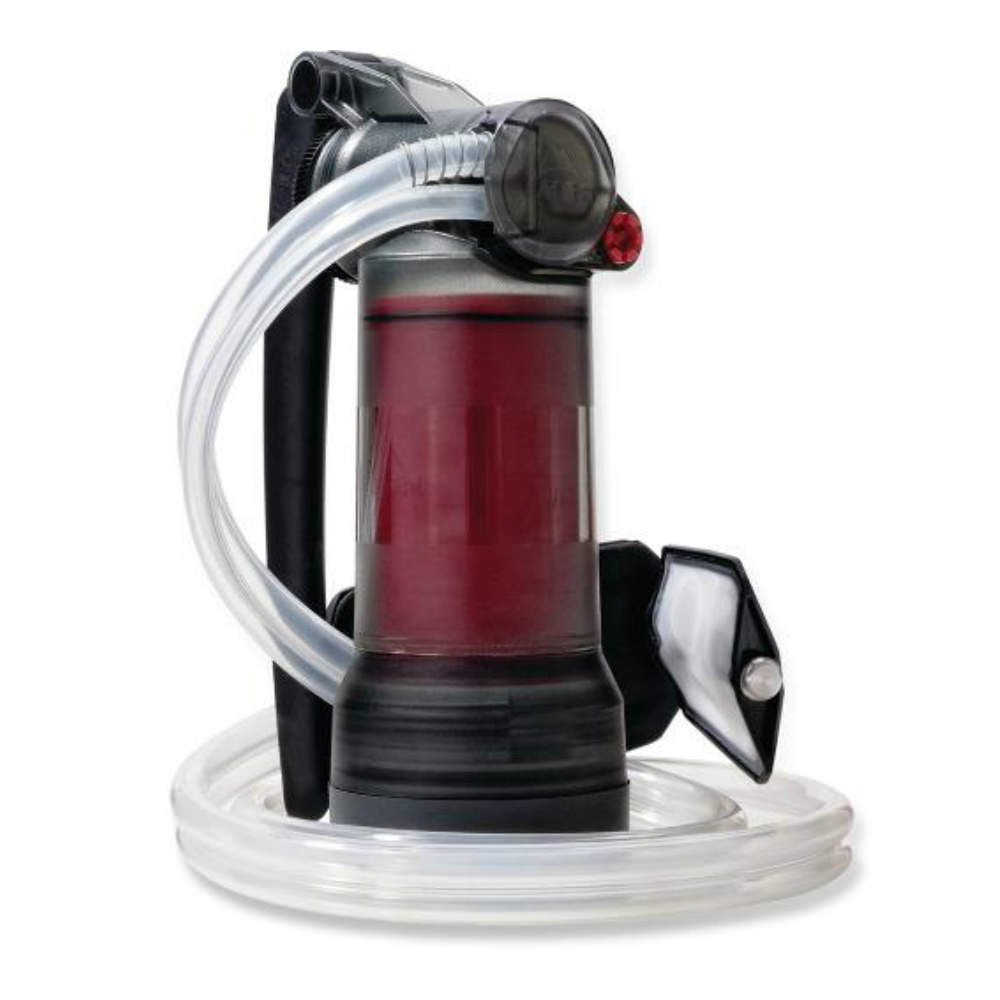
MSR Guardian
Best Filter for Purifying the Worst of the Worst Water
Price: $390
Weight: 1 lb. 1.3 oz.
Flow Rate: 2.5 L/min
Filter Pore Size: .02 microns
Lifetime Volume: 10,000 L
Pros
- Great flow rate
- Very durable
- Self-cleans as it filters
- Kills viruses
Cons
- Very heavy/bulky
- Very expensive
The MSR Guardian is a top-of-the-line pump purifier built for the harshest conditions. Since the Guardian is able to kill viruses, it’s particularly useful for remote international destinations.
One of the best features of the Guardian is the fact that it self-cleans with each stroke. Every pump circulates trapped dirt back out of the system to keep the flow rate high, pumping fatigue down, and maintenance to a minimum. And, like most pump filters, it features a burly pre-filter at the inlet that prevents most of the muck from making it to the filter element in the first place.
Though it’s built to withstand many years of rugged use, the upfront cost of this purifier is pretty staggering. It’s also too heavy to justify bringing on most backcountry trips. But ultimately it can save you money (and a ton of plastic waste) in the long run versus buying bottled water on trips where clean water is harder to come by if you travel a lot.
So if you’re looking for best-in-class protection from a purifier that’ll pull clean drinking water from the murkiest mud puddle on this planet, the Guardian should be your go-to. For ease of use, this filter works best when paired with a Wide-Mouth Nalgene bottle.
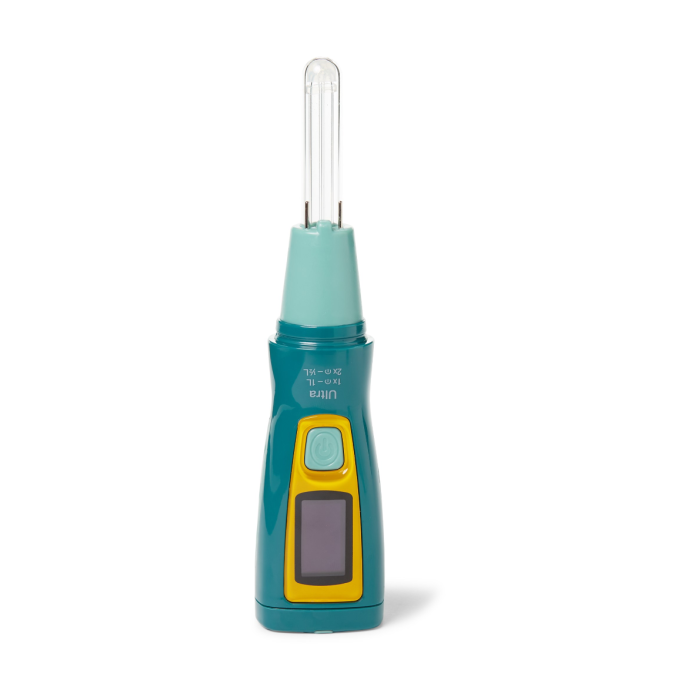
Katadyn Steripen Ultra
Best UV Light Water Purifier
Price: $130
Weight: 4.9 oz.
Flow Rate: N/A
Filter Pore Size: N/A
Lifetime Volume: 8000 L (50 L/charge)
Pros
- Lightweight
- Compact
- Easy to use
- Purifies quickly
- Kills viruses
Cons
- Expensive
- Need to keep the battery charged
- Isn't effective in murky water
We love the convenience and speed of the Katadyn Steripen Ultra UV light purifier. When paired with a small-mouth, 1-liter plastic bottle the Ultra is just about the fastest and easiest water treatment method we’ve ever used. Simply place the Ultra in your water bottle, flip it upside down, gently agitate for 90 seconds, and you’ve got a clean liter of water.
We can purify about five days of water for two people (over 50 liters) with the Ultra’s rechargeable internal battery. We don’t love that its functionality hinges on a battery, but we always carry a chemical purification method – like Katadyn Micropur or Aquamira – as a backup. We also always bring a power bank for charging important electronics, so we’ve never had a problem keeping the Ultra battery charged on trail.
The biggest downside with UV treatments like the Ultra is that they don’t work in murky water. The light needs to be able to penetrate the water molecules, so anything dirtier than a slight cloudiness will render the Ultra ineffective. For this reason, we reserve this water purifier for traveling in places where we’ll want to purify the tap water and for trips where clear streams and springs are the main sources.
Full Review: Katadyn Steripen Ultra
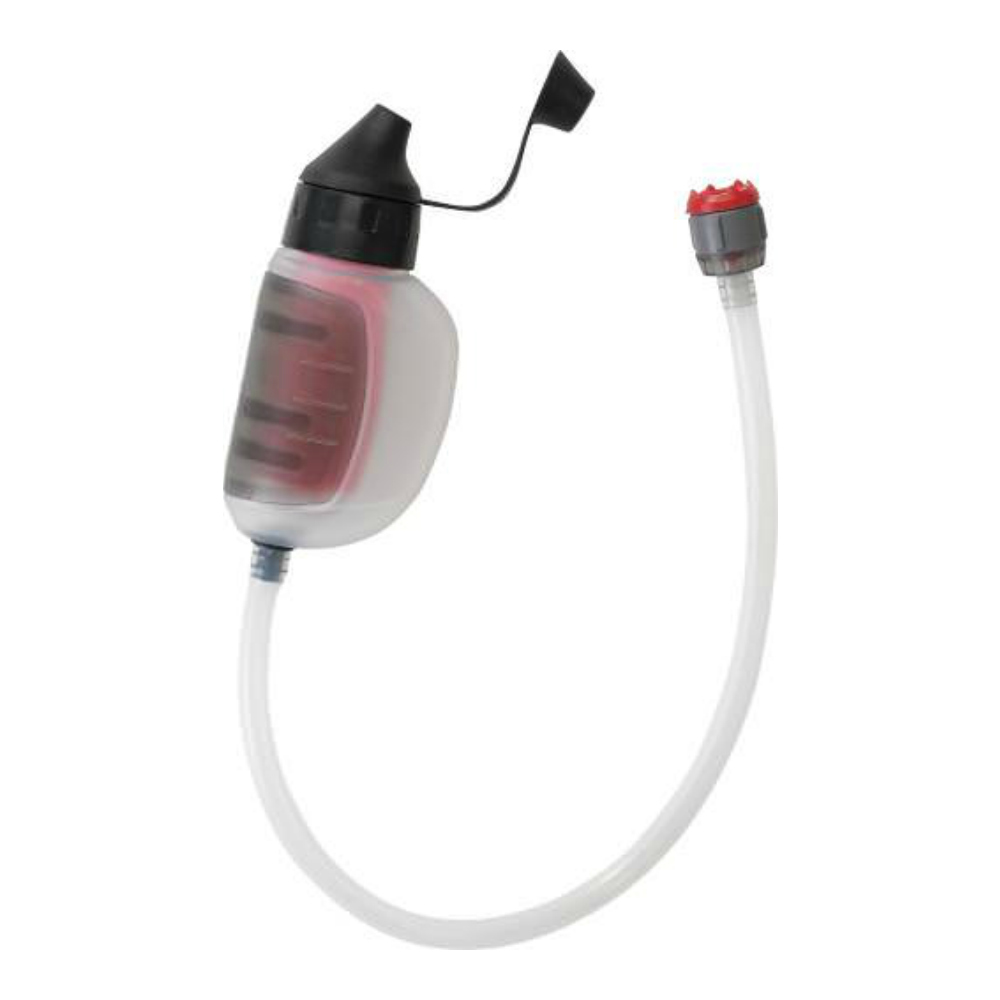
MSR TrailShot
Lightweight Filter that Works Well in Shallow Water Sources
Price: $63
Weight: 5.2 oz.
Flow Rate: 1 L/min
Filter Pore Size: .2 microns
Lifetime Volume: 2000 L
Pros
- Good for shallow sources
- Easy to clean in the field
- Very durable
Cons
- Hand pumping can be tiring
- Pumping becomes difficult as filter gets dirty
- Heavier than others
The MSR TrailShot is a lightweight pump filter with the ability to draw water from shallow streams and puddles, so this is a good choice for hikes in drought-prone areas.
The days of using a sad, curled-up leaf to scoop water from shallow sources are over. The TrailShot is designed with an inlet that pulls from any depth with a simple squeeze of the filter element housing. The pump action creates suction that takes in water and cleans it at a rate of one liter per minute, so it’s a real-time saver on trails where deep-flowing streams are scarce.
Like most pump/squeeze filters, hand squeezing six liters per day with the TrailShot can get annoying, but it’s not as bad as some of the more traditional pump filters we’ve used. We’ve pumped more than 200 liters of water through the TrailShot, and we’re very pleased with how long it maintains its flow rate.
Because the inlet pre-filters water and prevents larger debris from making it to the main filter element, it can handle pretty dirty sources without becoming difficult to pump. And when the flow rate does decrease, shaking the TrailShot a couple of times does wonders to restore the flow. The filter housing is also very durable, and the filter cartridge can be replaced once it’s reached the end of its usefulness.
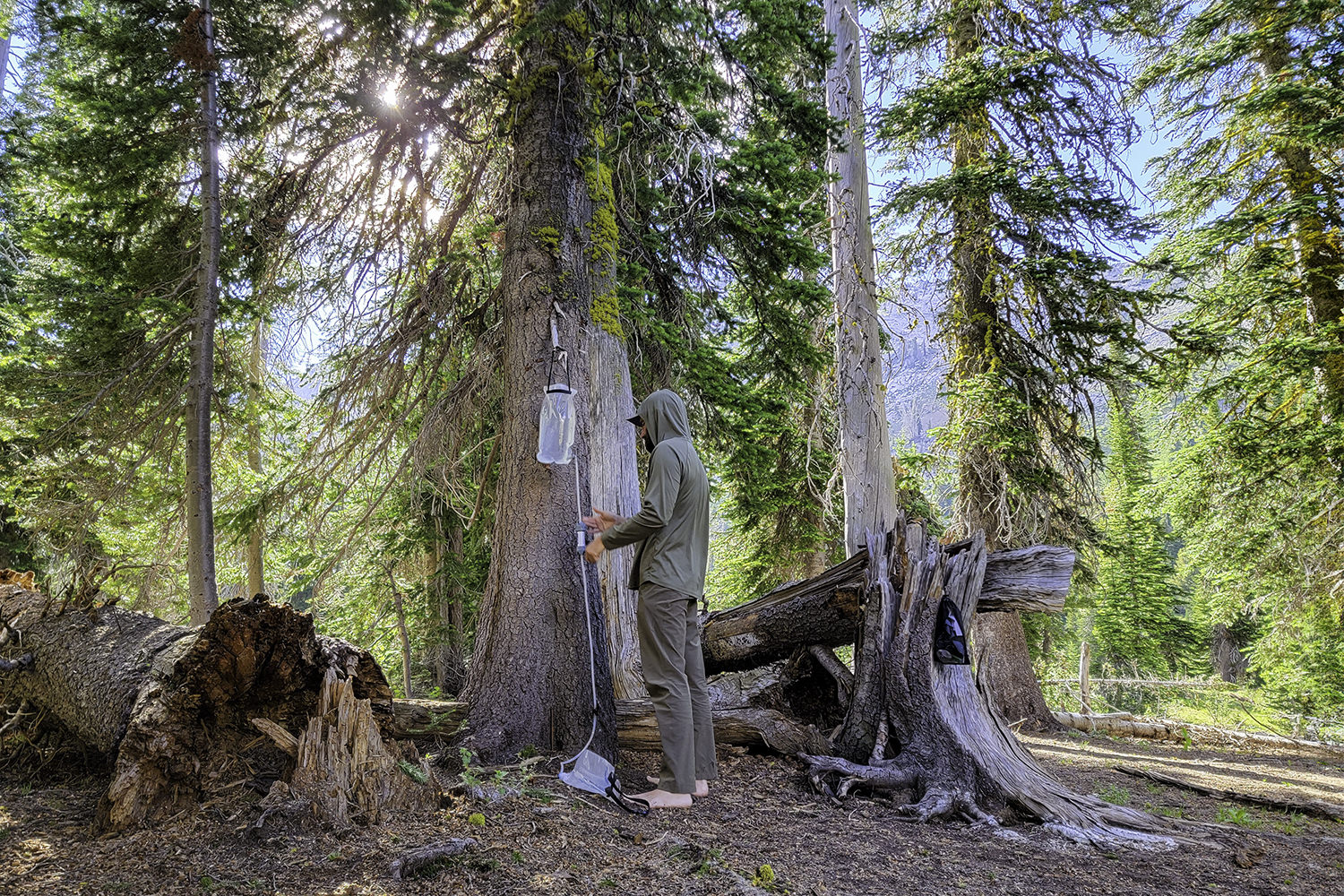
Product Comparison Table
| oSort | Product | Price | Weight | Flow Rate | Filter Pore Size | Lifetime Volume | Effective Against | Removes Particulates | Water Quality | Ease of Use | Treatment Time | Maintenance & Longevity | Weight Score | 0 |
Sawyer Squeeze View at REI View at Amazon |
$41 | 3 oz. (including a 32 fl. oz. pouch) | 1.7 L/min | .1 microns | 378,000 L | Bacteria, protozoa | Yes | 8.5 | 8 | 8.5 | 8 | 8.5 | 1 |
Katadyn BeFree View at REI View at Amazon |
$45 | 2.3 oz. (including 1 L soft bottle) | 2 L/min | .1 microns | 1000 L | Bacteria, protozoa | Yes | 8.5 | 8 | 8.5 | 7.5 | 9 | 2 |
Platypus GravityWorks View at REI View at Amazon |
$135 | 11.5 oz. (including 4 L reservoirs) | 1.75 L/min | .2 microns | 1500 L | Bacteria, protozoa | Yes | 8 | 9 | 8 | 8 | 6 | 3 |
Katadyn Micropur View at REI View at Amazon |
$16 | .9 oz. (30 tablets) | N/A | N/A | 30 L | Bacteria, protozoa, viruses | No | 6 | 9.5 | 6 | 10 | 10 | 4 |
Platypus QuickDraw View at REI View at Amazon |
$55 | 3.6 oz. (including 1 L reservoir) | 3 L/min | .2 microns | 1000 L | Bacteria, protozoa | Yes | 8 | 8 | 8.5 | 7.5 | 8 | 5 |
Sawyer Mini Water Filter View at REI View at Amazon |
$25 | 2 oz. (including a 32 fl. oz. pouch) | 1 L/min | .1 microns | 378,000 L | Bacteria, protozoa | Yes | 8.5 | 7.5 | 7.5 | 6 | 9 | 6 |
Katadyn Hiker View at REI View at Amazon |
$90 | 11 oz. | 1 L/min | .2 microns | 1100 L | Bacteria, protozoa | Yes | 8 | 8.5 | 7.5 | 7 | 6 | 7 |
Aquamira View at REI View at Amazon |
$15 | 3 oz. | N/A | N/A | 114 L | Bacteria, protozoa, viruses | No | 6 | 7.5 | 6 | 10 | 8.5 | 8 |
MSR Guardian View at REI View at Amazon |
$390 | 1 lb. 1.3 oz. | 2.5 L/min | .02 microns | 10,000 L | Bacteria, protozoa, viruses | Yes | 9.5 | 8.5 | 9 | 9 | 4.5 | 9 |
Katadyn Steripen Ultra View at REI View at Amazon |
$130 | 4.9 oz. | N/A | N/A | 8000 L (50 L/charge) | Bacteria, protozoa, viruses | No | 6 | 9 | 9.5 | 8.5 | 7.5 | 10 |
MSR TrailShot View at REI View at Amazon |
$63 | 5.2 oz. | 1 L/min | .2 microns | 2000 L | Bacteria, protozoa | Yes | 8 | 6.5 | 7 | 7 | 7.5 |
|---|
How we Test & Methodology
For water filters, we look at five different dimensions of performance during our rigorous field testing: water quality, ease of use, treatment time, weight, and maintenance and longevity.
WATER QUALITY
Water quality is two things – what kinds of harmful organisms, viruses, and chemicals a treatment type removes, as well as what the resulting water looks like and tastes like. Products that neutralize a wider range of things are often more appealing. We check manufacturer claims in conjunction with our real-world experience to validate the efficacy of each product. To test for clarity and taste, we simply sample from a water source and compare the before and after treatment results for each looking for clear water free from visible organic material. We also drink side-by-side and assess each purified liter for any unpleasant taste or odor.
EASE OF USE
For ease of use, we assess how long it takes and how intuitive it is to start the filtering process. We consider the level of compatibility of each treatment with different types of bottles, bladders, and other containers. We also look at the moving parts – the level of assembly required, as well as the amount of active work involved in treatment versus passive waiting.
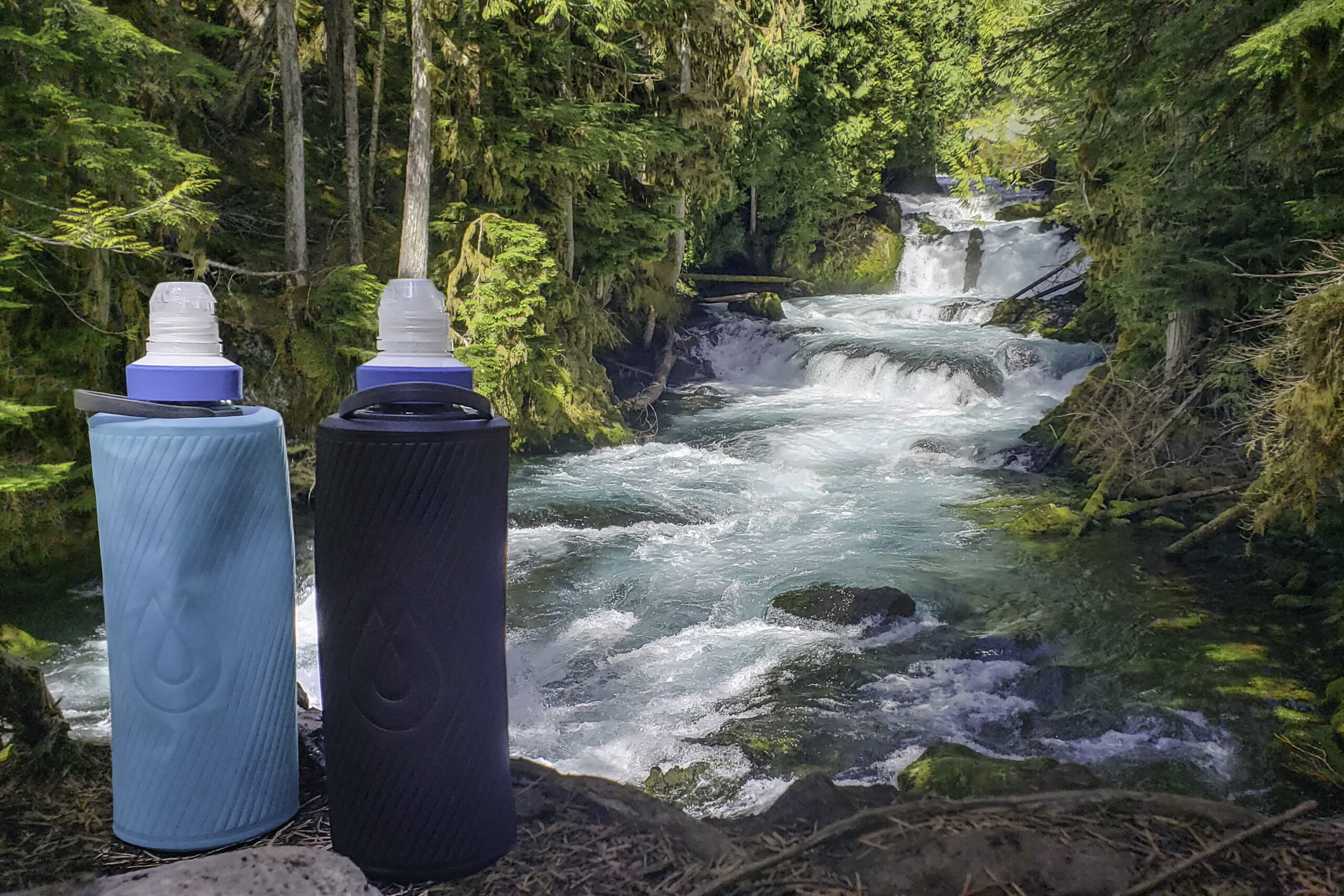
TREATMENT TIME
To determine treatment time, we take a liter of water from a source and measure how long it takes from the start of treatment to when the full liter is safe to consume. We also assess flow rates to determine whether a certain model is well-suited for larger groups or if it is best for solo use.
WEIGHT
As with many other pieces of backcountry gear, we look at manufacturer claims and weigh each model. We note what type of container each treatment type comes with and consider that in the overall weight.
MAINTENANCE & LONGEVITY
We use our experience to determine how often a treatment type requires maintenance (e.g. through backwashing or battery changing) with regular use. We can compare the original flow rate to the actual flow rate after pumping through 50 liters of typical backcountry water from a variety of sources. We also assess how much effort it takes to clean a particular product and get it working like (or as close to) new as we can. We also take into consideration any expiration dates, claimed lifetime flow volume, and other risks inherent to the type of product (e.g. filters freezing).
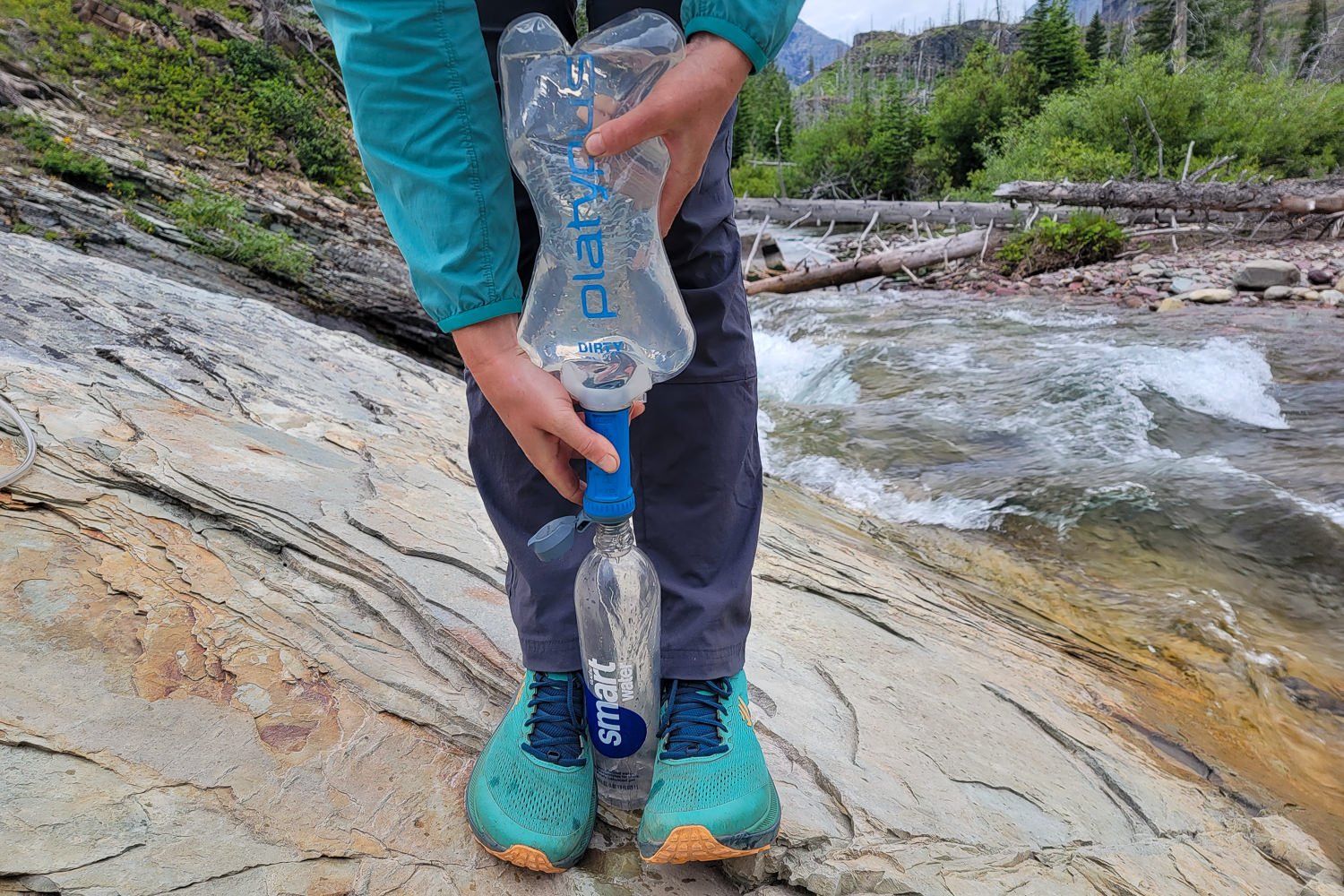
Why Trust CleverHiker
Our team has treated 100,000 liters of water across our backcountry adventures using pretty much every type of treatment technology out there. Senior Gear Analyst and lead water filter tester, Casey Handley, has thousands of miles of hiking under her belt in some of the hottest, driest deserts in the U.S. From stagnant stock troughs on the Arizona Trail to the heavily used water sources of the Appalachian Trail, she has had to rely on and trust in a wide array of filters and chemicals to stay hydrated. This hands-on experience, as well as her time at REI, makes her uniquely positioned to assess the treatments in this lineup.
Analysis & Results
In this section, we outline the top performers in each metric after our rigorous hands-on testing and compare different features, facets and specs of each to help you decide which one is right for you.
WATER QUALITY
When it comes to water quality, the MSR Guardian has some of the best filtration around. Its super small .02-micron hollow fiber filter removes bacteria, protozoa, viruses, and particulates, making it one of the few portable filters effective against viruses. During tests, the Guardian excelled in providing clean, clear water with no discernible offensive taste and we’ve never had any reason to doubt its efficacy.
The Sawyer Mini and Sawyer Squeeze are all but identical in this metric. Both filter our bacteria and protozoa (i.e. giardia). Though their .1 micron filters are too large to remove viruses, these two still produce crisp, fairly clear, neutral-tasting water, even from silty sources. The Katadyn BeFree is very similar with a .1 micron hollow fiber filter that is good for bacteria and protozoa.
If you are looking for alternative treatment methods, the liquid Aquamira and tablet Katadyn Micropur are both reliable virus killers. This is also true of the Katadyn Steripen Ultra. The reason these three don’t score higher here is that none of them do anything for particulates. If you have a silty, organic-tasting source, the treated water is going to stay silty and organic-tasting. The UV light of the Steripen Ultra also requires a certain level of pre-treated clarity to be effective in the first place, so we prefer the security of mechanical filtration or chemical treatments.
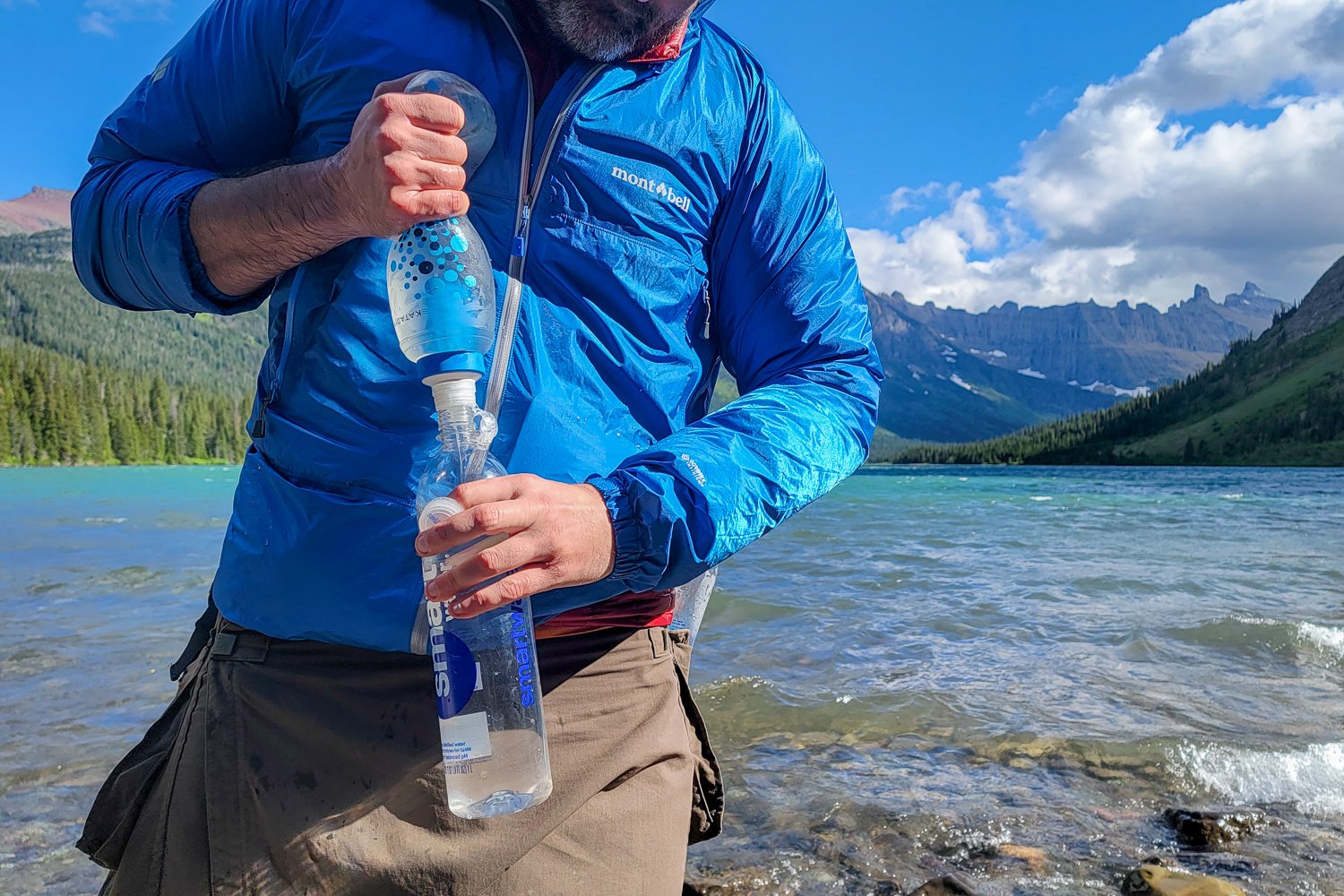
EASE OF USE
For ease of use, it’s hard to beat Katadyn Micropur tablets. You just drop one tab into a liter of water and wait for the required time (15-30 minutes for bacteria and protozoa, 4 hours for viruses). Also in its favor, it works with any container – bottle, bladder, Ziploc bag, whatever. There are no moving parts and beyond dropping in the tab and threading the container at the end, the treatment process is entirely passive.
Although it takes a little time to understand initially, the Platypus GravityWorks is easy to set up and once you hang it, gravity does the rest, with the untreated pouch flowing into the clean water reservoir below it. It comes with a 4-liter dirty reservoir and a 4-liter clean reservoir but you can use it with other containers with the right attachments.
The Katadyn Steripen Ultra is altogether different from anything else on this list but intuitive to use – just turn it on, insert into water, and stir for 90 seconds. We love that the device indicates when the process is complete. Though it is much easier to use with wide-mouth bottles like Nalgenes (or, honestly, a pot), it only takes the minute and a half of active stirring and the process is over with.
The MSR Guardian and Katadyn Hiker both require pumping but they are compatible with a range of bottles and bladders so all-in-all still relatively easy to use compared to others on the list that require even more effort to squeeze for even less water.
TREATMENT TIME
The Platypus QuickDraw stands out here with the fastest flow rate, filtering up to three liters per minute, making it incredibly efficient for quick hydration on trail. This makes it slightly speedier than the MSR Guardian, which still has an impressive flow rate of 2.5 liters per minute, however, the overall time it takes to get clean water is longer with this model because it requires pumping, which gets tiring after a while.
The Katadyn BeFree and Sawyer Squeeze are comparable, with the BeFree treating up to 2 liters per minute (30 seconds per liter) and the Sawyer Squeeze handling about 1.7 liters per minute (35 seconds per liter). Both of these filters are speedy, but the BeFree’s flexible design and ease of squeezing often make it feel faster and more convenient (however, both can take much longer if they haven’t been cleaned in a while).
The Platypus GravityWorks treats 1.75 liters per minute, meaning its four-liter capacity can be finished in under three minutes. While this is slower than some of the more active methods, its capacity means you end up with a larger volume of water in less time since you don’t have to refill anything.
In contrast, the Katadyn Steripen Ultra is done in 90 seconds flat for one liter. While its “flow rate” is not as fast as the mechanical methods, there’s no jostling with multiple containers and it is a consistent time throughout a trip – it can’t clog.
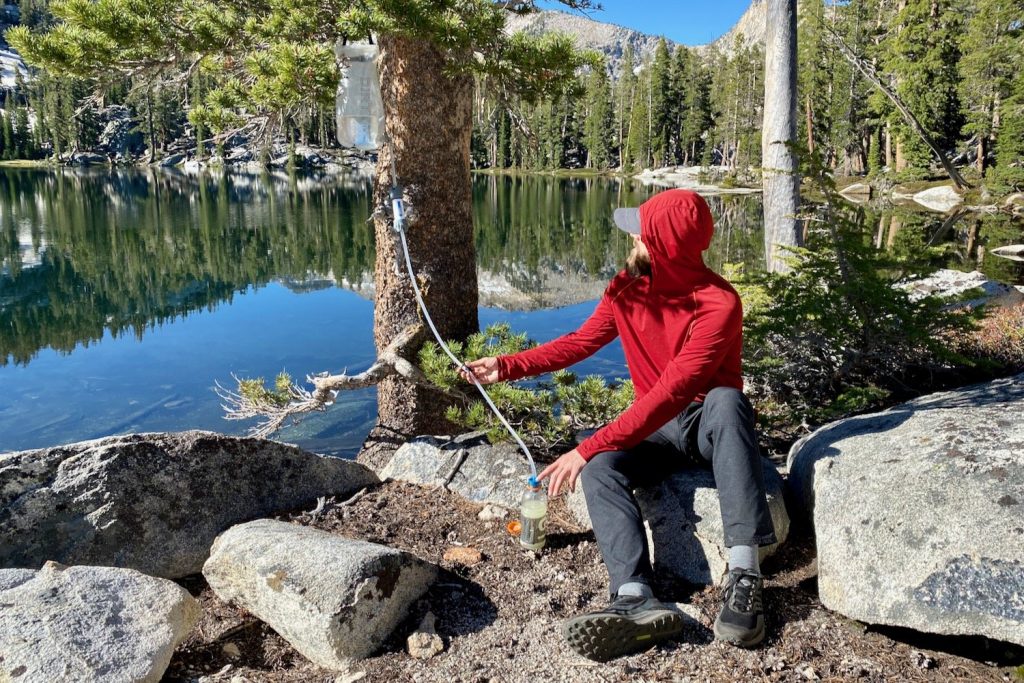
WEIGHT
Among the lightest options, Katadyn Micropur stands out for its minimal weight – less than an ounce for a package of tabs. The discreet blister packs make them incredibly convenient for ultralight backpacking and emergency situations and you can choose exactly how many to take with you, giving you the flexibility to adjust weight even more.
Though it is a liquid treatment option, a pair of part A and part B Aquamira bottles comes in at three ounces, making it an excellent choice for those who need a lightweight but effective chemical treatment method. In addition, the bottles get lighter as you go as opposed to a mechanical filter.
The Sawyer Mini and Sawyer Squeeze are our favorites for their compact and lightweight design. The Sawyer Mini is particularly impressive, weighing only a couple of ounces. It’s one of the lightest filtration systems available and includes a squeeze pouch, straw, and cleaning plunger, all without adding significant bulk. This makes it an ideal choice for ultralight backpackers who need reliable filtration without extra weight. The Sawyer Squeeze is a slightly heavier three ounces. Despite the minor weight increase, it’s still highly portable and it is one of our absolute favorites overall.
At a scant 2.3 ounces, the Katadyn BeFree is right on par with the Sawyer Mini. Its flexible bottle also allows it to compress when empty, saving space in your pack. And at just over three ounces, the Platypus QuickDraw is another versatile and lightweight system that includes a collapsible reservoir.
MAINTENANCE & LONGEVITY
At the top of the list, Katadyn Micropur tabs and Aquamira drops require zero maintenance. The only thing to keep in mind is shelf life. The Micropurs typically last around 5 years if stored properly. Aquamira has a similar use window of about 4-5 years for an unopened package but need to be used within a year once opened.
The MSR Guardian, Katadyn Steripen Ultra, Sawyer Squeeze, and Platypus GravityWorks require varying levels of maintenance but offer significant longevity.
The Guardian has a nifty self-cleaning mechanism that flushes some of the pumped water back through the system which reduces the need to manually backflush. Each filter cartridge has a lifespan of to 10,000 liters, making it a durable option for long-term use.
The Steripen obviously doesn’t require any backflushing, which is a huge plus, but it does have to be charged and the bulb has a lifespan of about 8,000 liters. On the other side of the spectrum, the Sawyer Squeeze requires somewhat regular backflushing with the included syringe. It claims to last up to 378,500 liters, which is phenomenal, but in practice, we usually have enough concerns about whether or not it froze or is irredeemably clogged that we swap it out well before that.
Lastly, the Platypus GravityWorks system also benefits from periodic backflushing to maintain flow rate. Its filter can treat up to 1,500 liters before replacement.
How to Choose a Water Filter
TYPES OF WATER TREATMENT
Chemical – Chlorine Dioxide
- Works by killing the bad stuff with chemical drops or pills
- Kills bacteria, protozoa & viruses
- Very lightweight & easy to use
- Relatively affordable (drops normally cost less than pills)
- Relatively foolproof (no clogging, breaking, or maintenance)
- 4 hour wait time required (more info below)
Note: There are other chemical treatment options, but we recommend chlorine dioxide drops or purification tablets because they’re effective against cryptosporidium, and most others are not.
Chlorine Dioxide Wait Time: In order for chlorine dioxide to be effective against cryptosporidium, a 4 hour wait time is required. Giardia, bacteria, and viruses are all killed in about 30 minutes, but crypto takes longer to kill. When we judge a backcountry water source to be clean (read “judge the source” section above), we normally just wait the 30 minutes. If we don’t trust the water source, we wait the full 4 hours. Obviously, this is a personal choice that’s up to you.
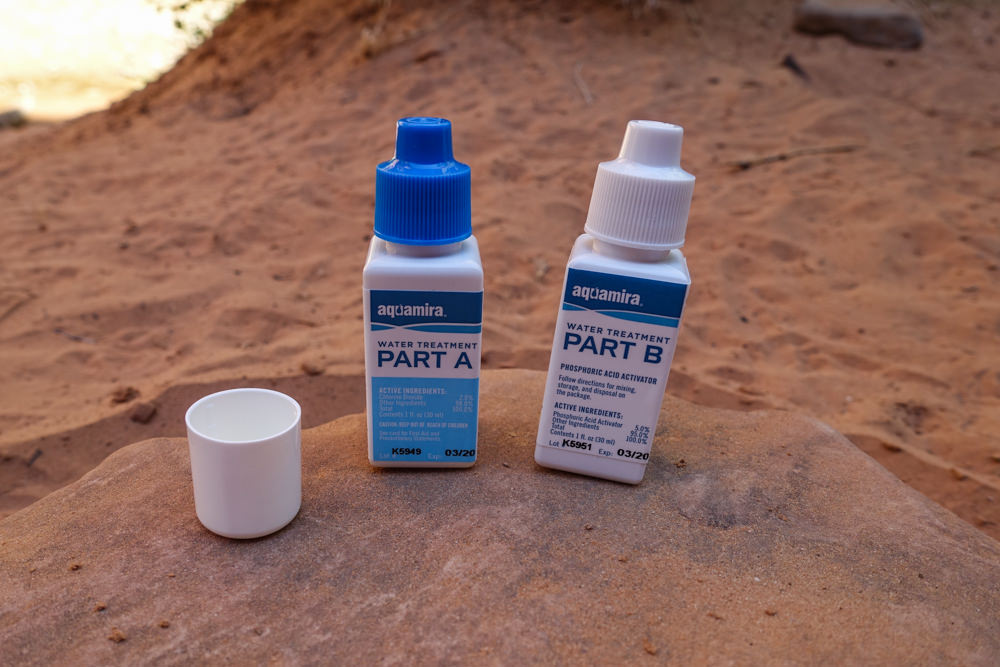
Filters
- Works by filtering out the bad stuff & letting clean water pass through
- Allows you to drink clean, cold water right away
- Many filters require work (pumping, squeezing, etc)
- Gravity filters don’t require much effort & can be good for groups
- Filters are not effective against viruses, but purifiers are (read “viruses” section above)
- Prices vary – pump & gravity filters tend to be more expensive than squeeze filters
- Weights vary – pump & gravity filters tend to be heavier than squeeze filters
- Some maintenance normally required (backflushing, cleaning, etc.) to keep up flow rates
- The flow rate of nearly every water filter will decrease with use – the dirtier the water source, the faster your filter’s flow rate will decrease; eventually needs to be replaced
- Freezing will break most filtration units
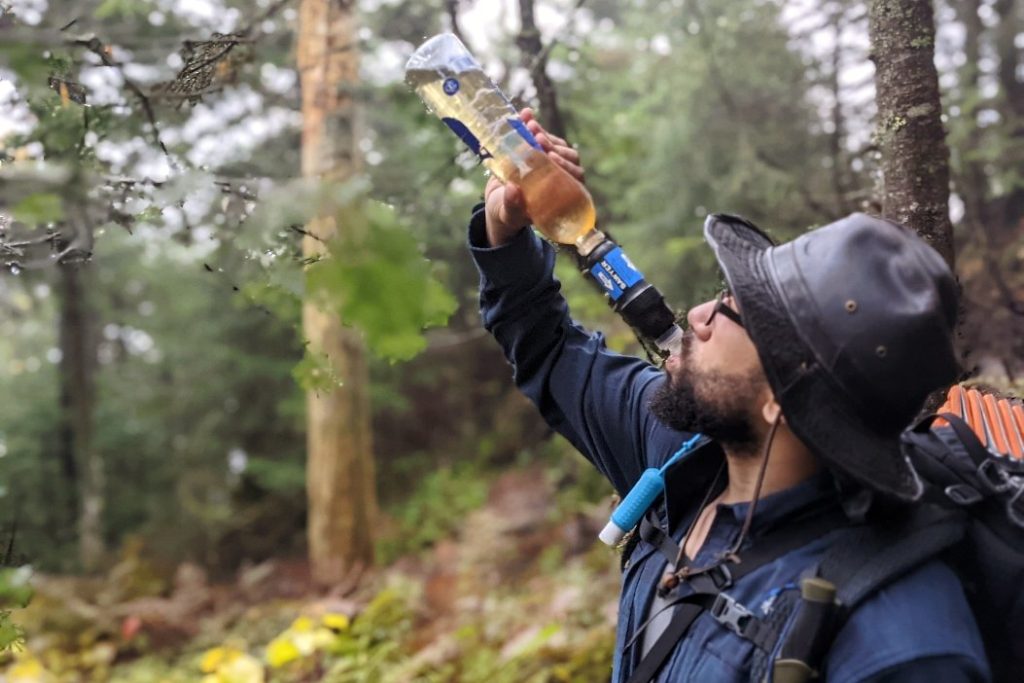
UV Light Purifiers
- Works by sterilizing the bad stuff with ultraviolet light
- Kills bacteria, protozoa & viruses
- Allows you to drink clean, cold water right away
- Requires minimal effort & works quickly
- UV purifiers tend to be more expensive
- Requires batteries & could malfunction in the field
- Clear water required for UV treatment; not a good choice for murky sources
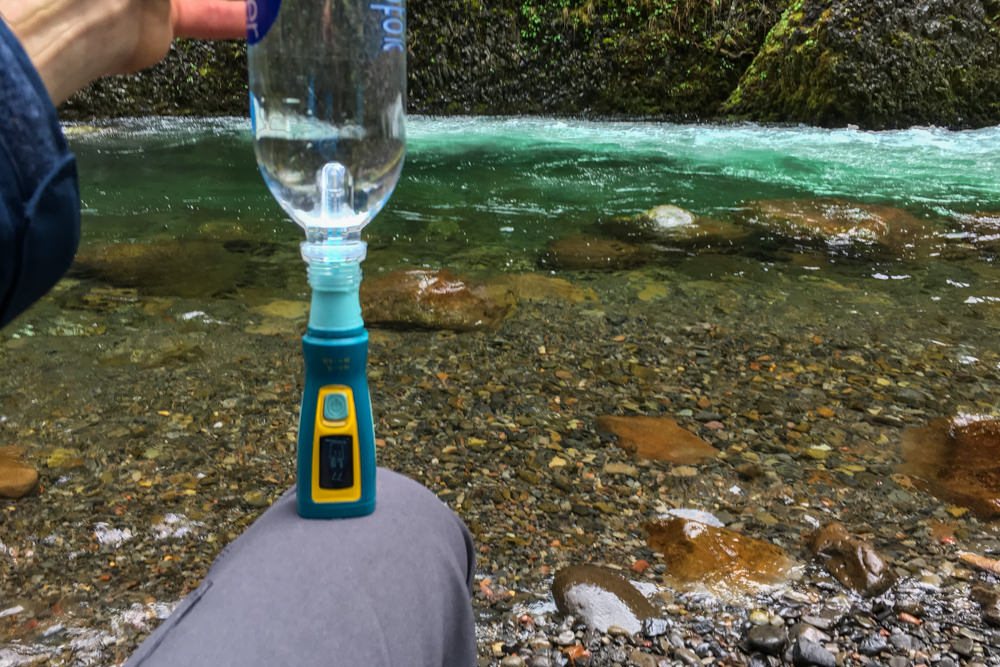
Boiling Water
- Boil water for 1 min (or 3 min over 6,500 feet) to kill bacteria, protozoa & viruses
- Requires extra stove fuel & cooling time
- Not a primary treatment method, but useful when you’re already cooking
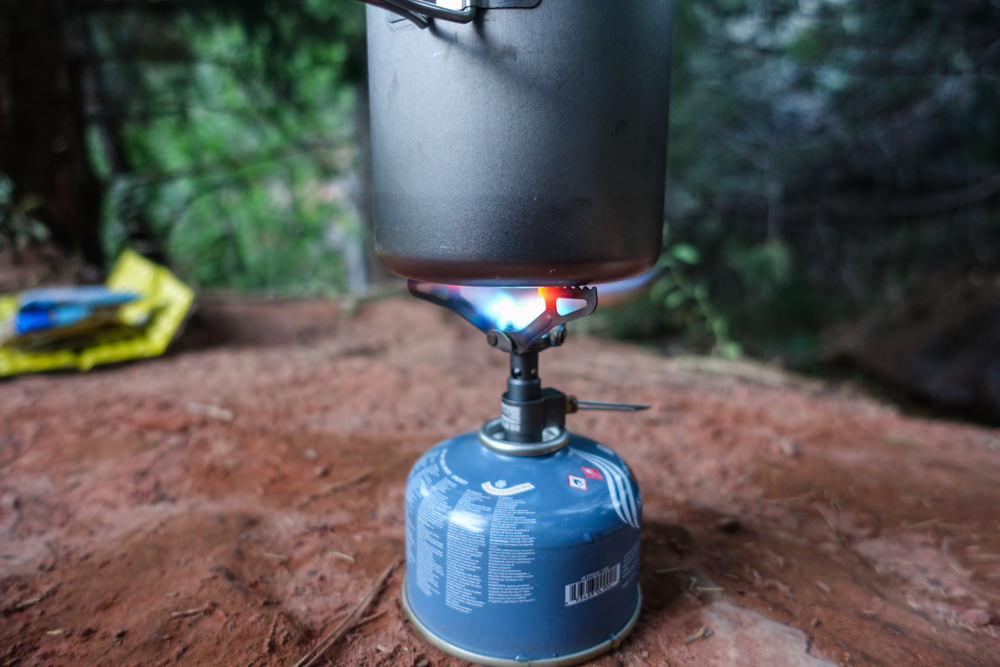
PRICE
The price of different filtration and purification methods varies widely, but the top consideration should always be getting the most effective and reliable option for your needs.
Chemical treatments tend to be the lowest cost options upfront, squeeze and pump filters are typically a good value and are the most popular with backpackers, and UV water purifiers tend to be on the more expensive side.
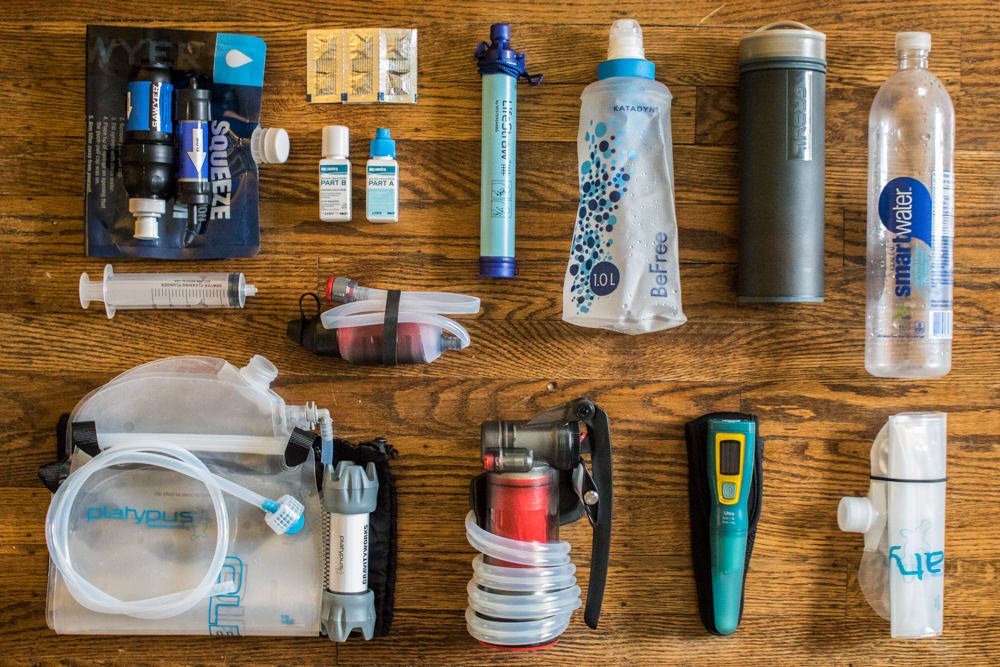
WEIGHT
Squeeze filters and chemical treatments are a lightweight and convenient way to get clean water in the backcountry. Squeeze filters are the most common ultralight option since most backpackers find the occasional cost of replacement worth the weight savings over gravity and pump filters.
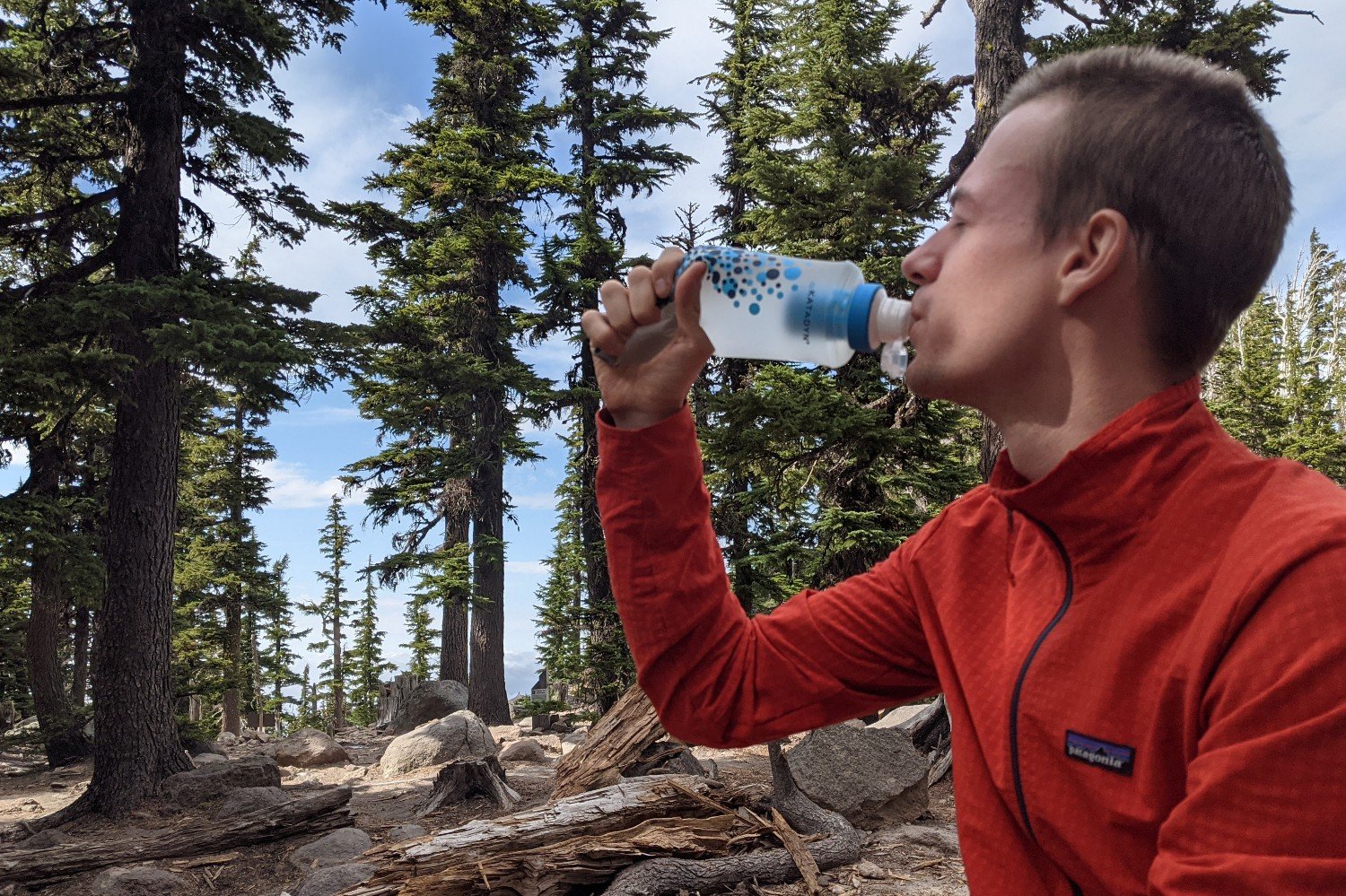
EASE OF USE
You’ll need to treat water multiple times a day in the backcountry. If your purification method is obnoxious, you’re bound to get annoyed with it quickly. We always prioritize treatment options that are easy to use.
Chemical treatments, squeeze filters, and gravity filters (for groups) are usually the most convenient ways to get clean water, but UV purifiers are also simple to use as long as you keep the battery fresh.
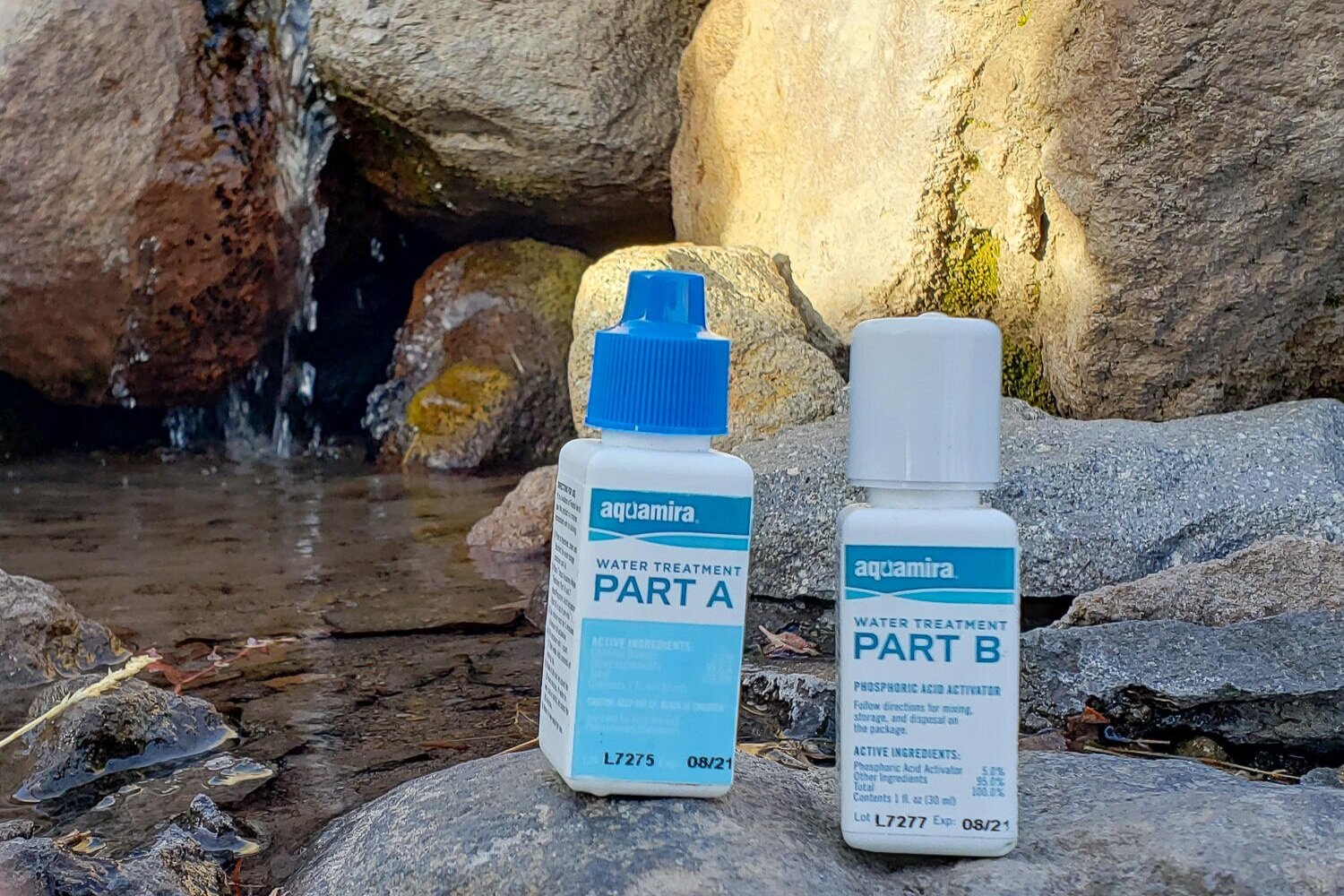
HAVING A BACKUP METHOD
Just like any important backcountry tool, you’ll want to have a backup plan if your water treatment method fails. Water filters can clog, squeeze bags can break, and UV purifier batteries can die. So regardless of your treatment method, we always recommend bringing backup chemical treatment pills. We’ve had to rely on backup pills several times and have always been happy to have them.
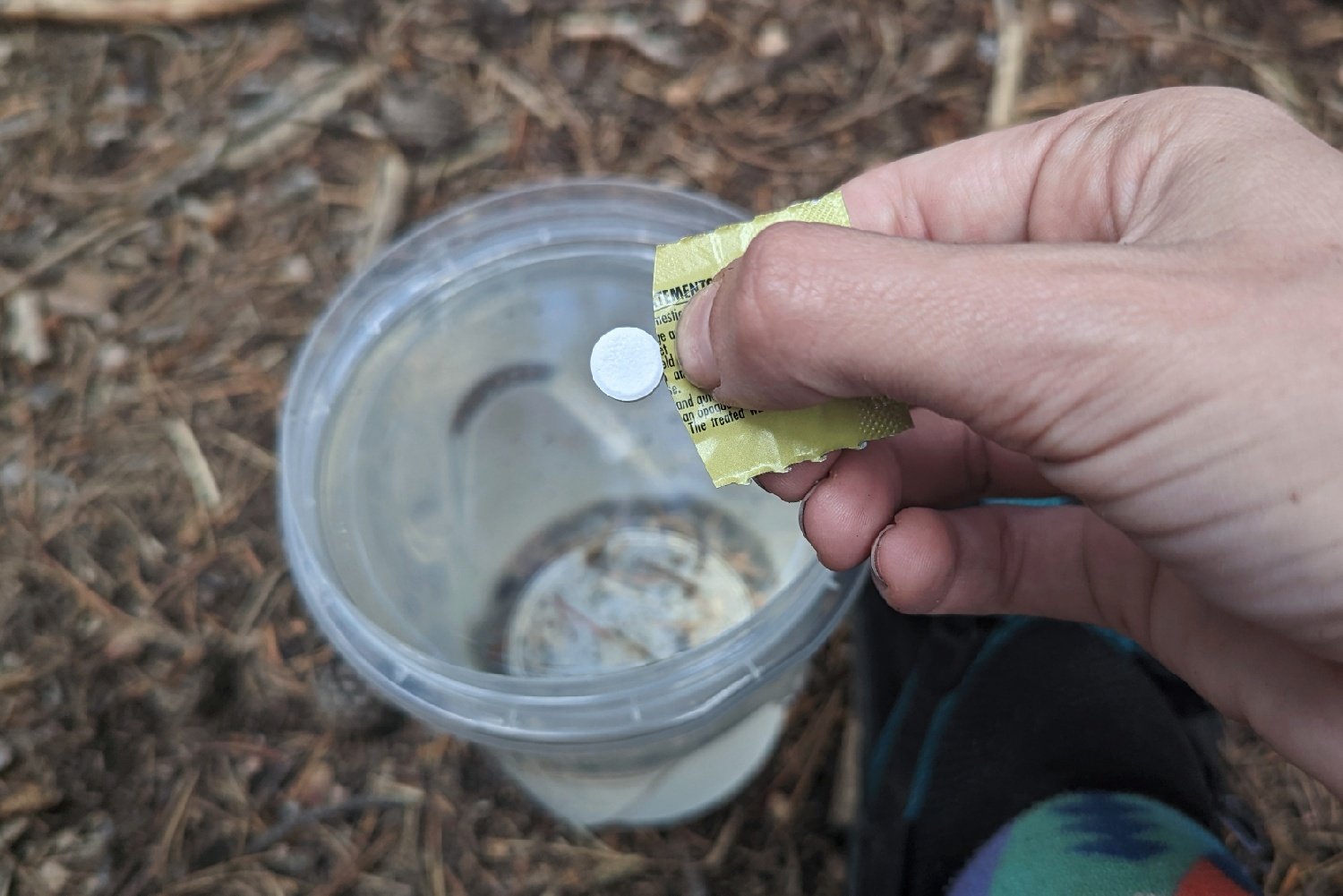
LEAVE NO TRACE
It’s gross to think about, but most backcountry water contamination is a result of feces – either from humans or animals. That’s why you can’t talk about clean water without talking about LNT. When you need to crap in the woods, ALWAYS dig a cathole 6-8 inches deep and do your business at least 200 feet from any water source. Use toilet paper sparingly and either bury it thoroughly or pack it out in a Ziploc bag. We use a cheap, lightweight snow stake for digging and it works great. C’mon people, you love nature, that’s why you’re out there. So please put in a little effort to keep things clean for generations to come.
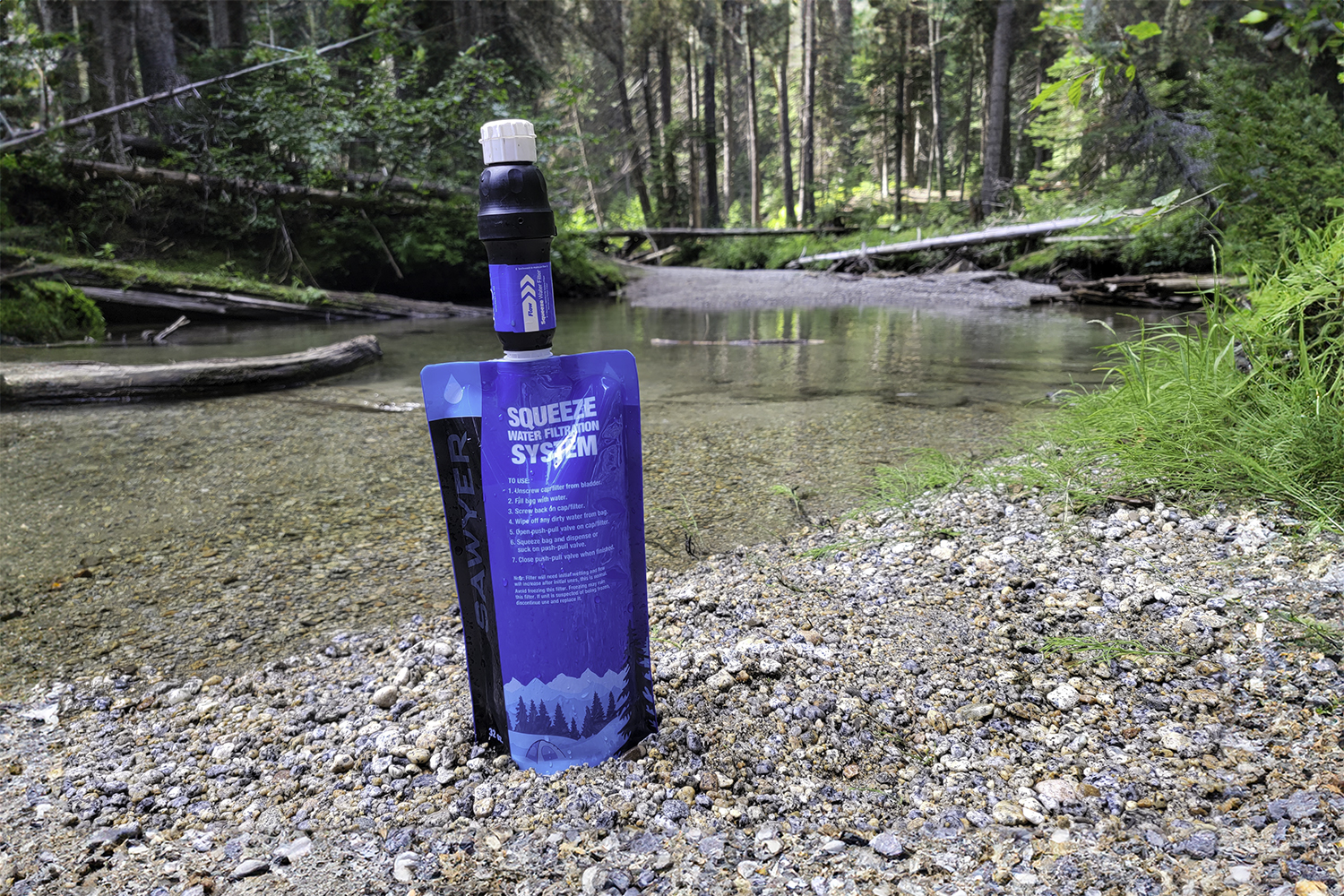
JUDGE THE SOURCE
Choosing clean water sources is one of the best ways to avoid contamination in the backcountry. When choosing a water source, look for clear, cold flowing water. Medium size streams are usually ideal. Lakes can be a good choice as well, but sediment and bacteria do tend to build up around shorelines, so flowing water is preferable. Feces tends to be the biggest culprit in water contamination, so always avoid areas with lots of human or animal activity (pastures or meadows for example). Rain can make matters worse by washing contaminants and sediment into water sources. Snow should always be boiled for about one minute or melted and treated, because it can contain contaminants as well.
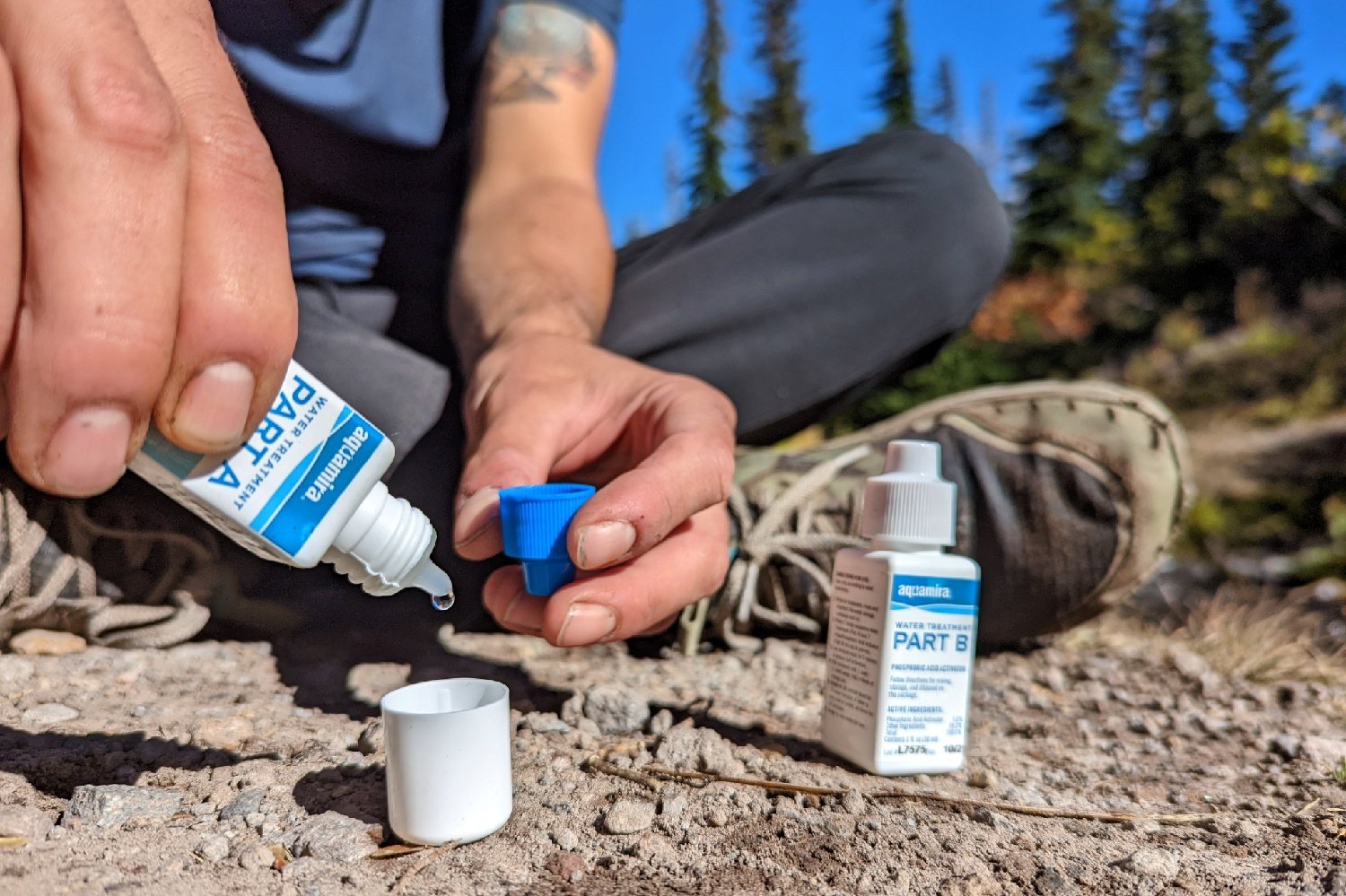
PRE FILTERING
Small bits of organic matter (leaves, algae, etc.) usually pose no threat, but you can use a pre-filter (bandana, pantyhose, etc.) to strain out debris before treating your water. When water sources are clear, we don’t bother with pre-filtering, but we often bring a small clipping of pantyhose just in case. Pre-filtering will make any water treatment process more effective and will extend the life of your water filter.
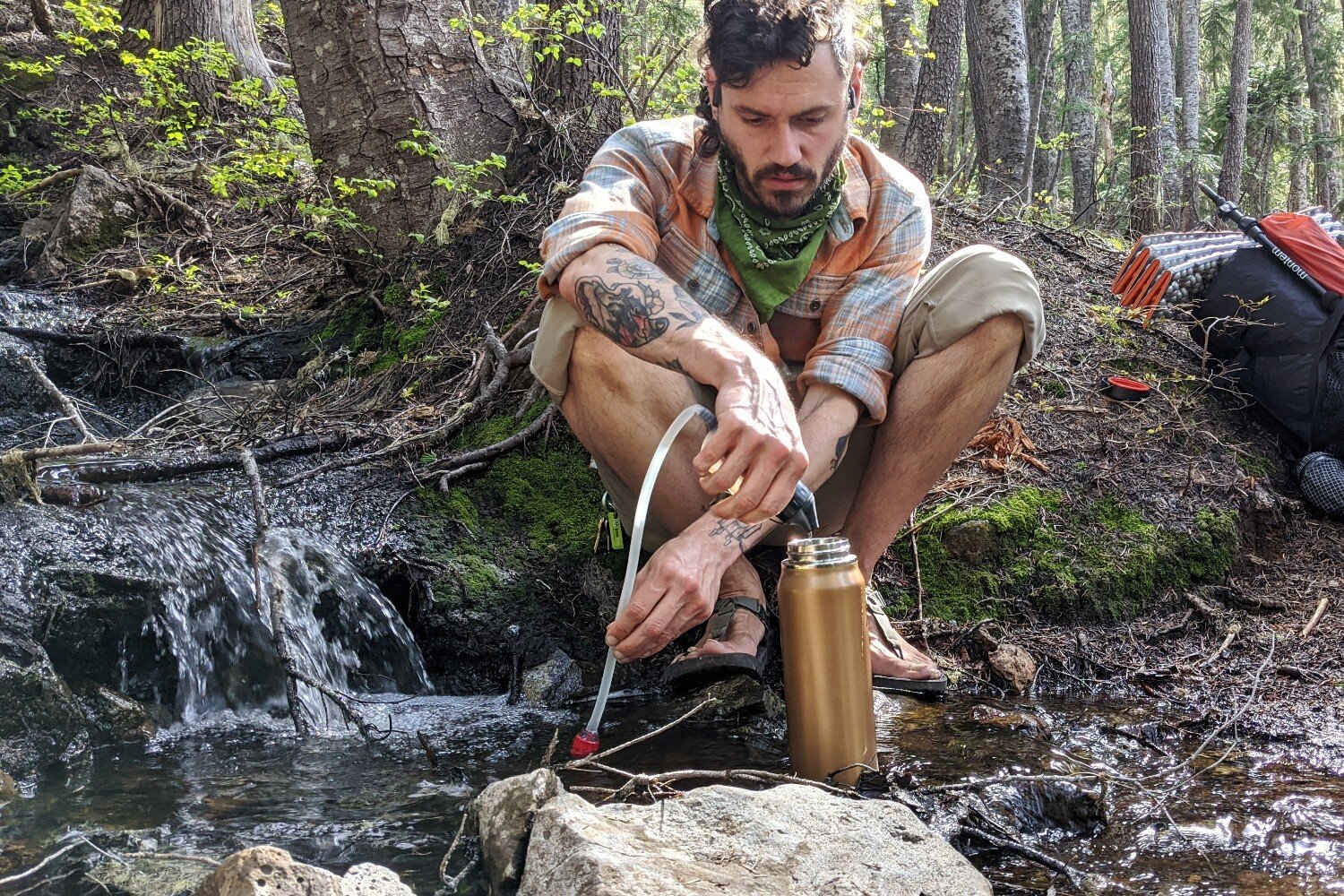
WASH YOUR HANDS
Many people blame water sources when they get sick in the backcountry, but improper hygiene is often the real culprit. A small bottle of hand sanitizer should be considered essential for any backcountry trip. Use it after bathroom breaks and before eating.
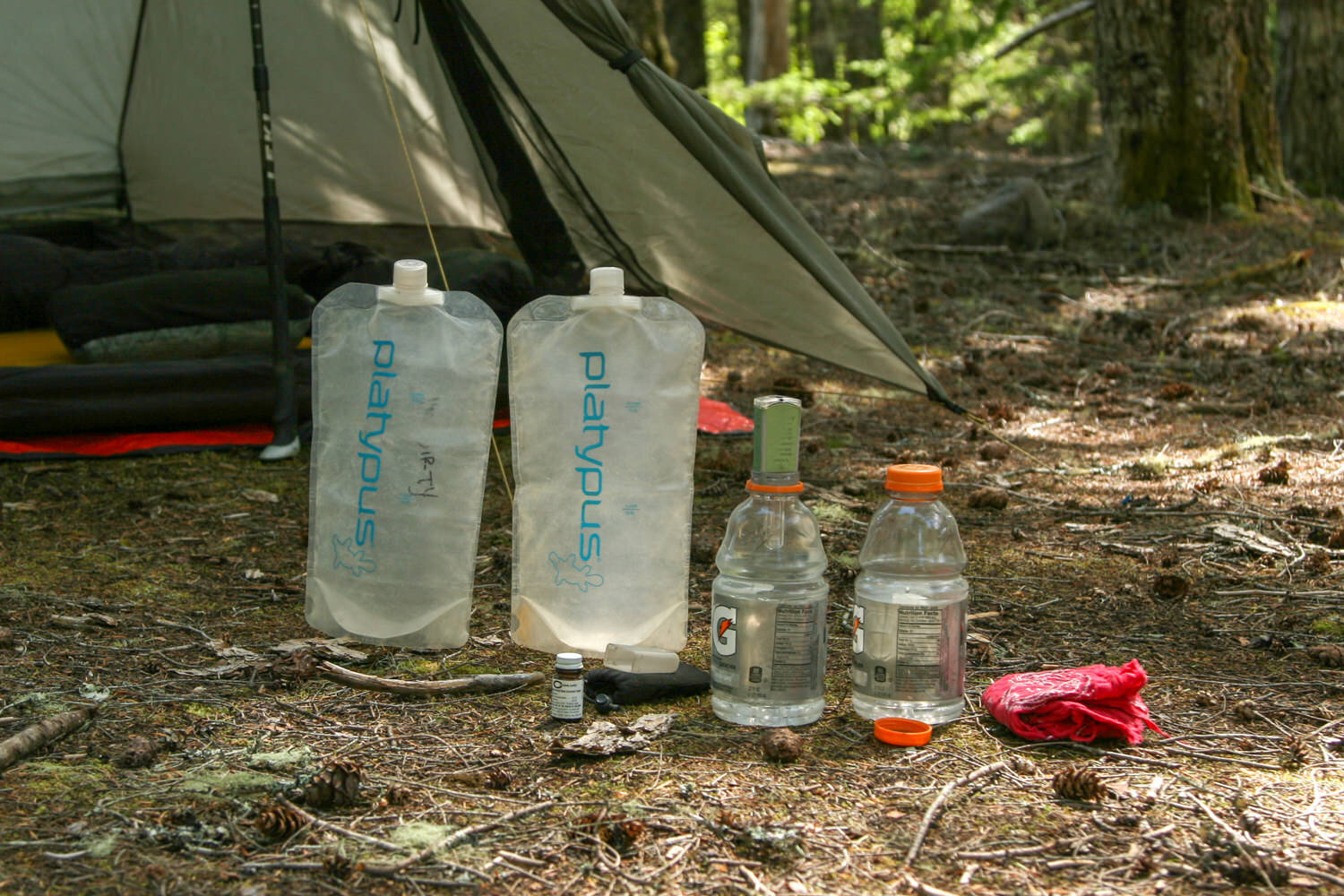
BOTTLES & BLADDERS
We use small-mouth plastic bottles (e.g. smartwater) on the majority of our backpacking trips. They’re lightweight, affordable, and they last a long time. When we need to carry lots of water over long dry stretches, we use trusty Platy Bottles to store water in our packs. Check out some of our other favorite water bottle options on our Best Water Bottles list. Some backpackers like to use hydration bladders, but we generally find them to be too much hassle and we’ve had a few leak in our packs.
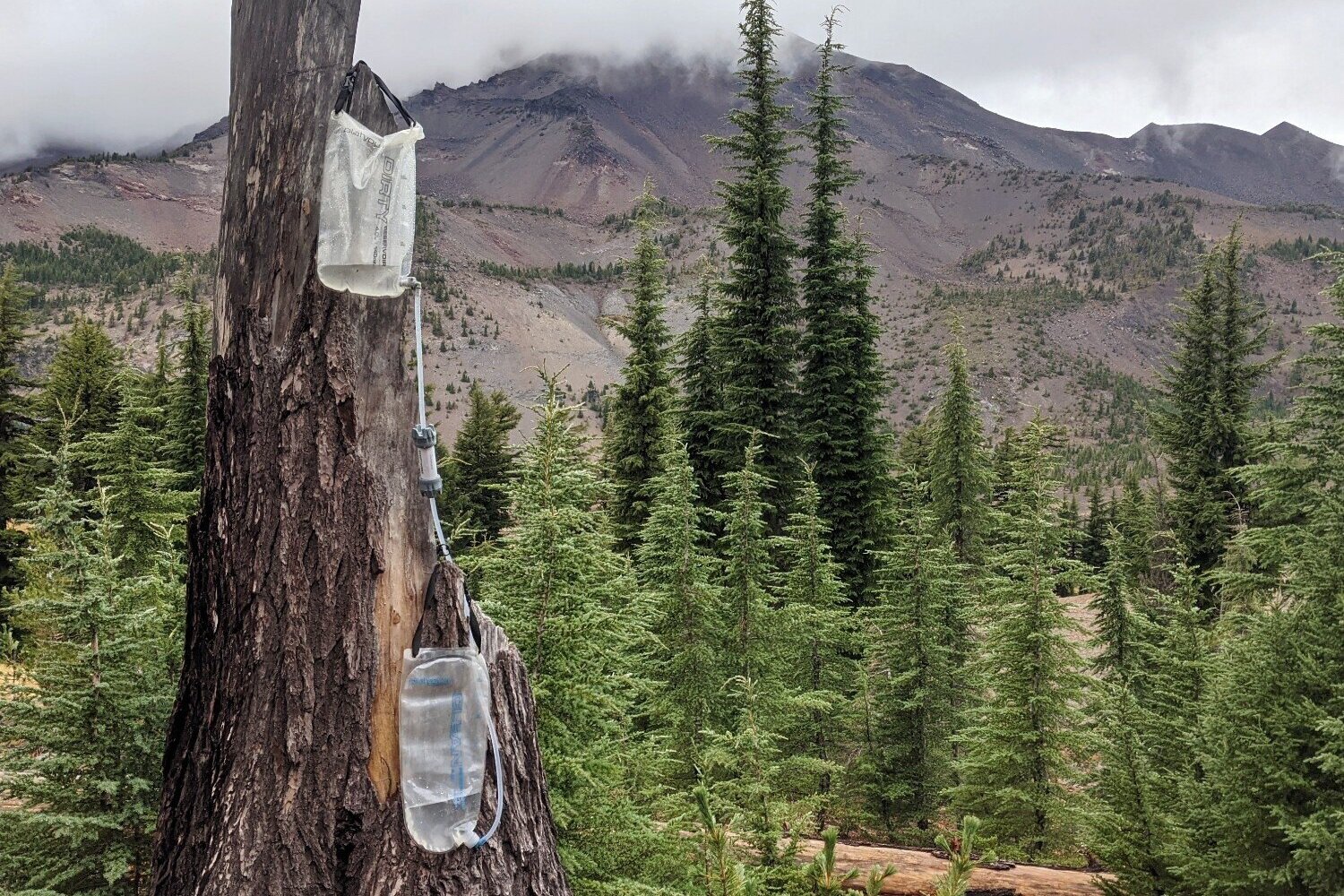
Honorable Mentions
The following water filters didn’t make our final list, but they’ve still got a lot of good things going for them. You never know, one of these water filters might be perfect for you:
LifeStraw Peak Squeeze – This is another compact and convenient squeeze filter. The reservoir is durable and we like that the filter cartridge can be used in multiple ways. That said, it weighs a little more than other squeeze filters on the market (3.9 oz.), and its flow rate didn’t blow us away. There are a lot of things going for the Peak, but ultimately, we prefer the designs of the Sawyer Squeeze, Katadyn BeFree, and Platypus QuickDraw squeeze filters.
Katadyn Hiker Pro Clear – This filter can pull water from tough to reach sources, which can often be helpful in the backcountry. Comparing cost, weight, and ease of use, we prefer more convenient treatment methods (ex: GravityWorks, Steripen Ultra) and lightweight, affordable systems (ex: Chlorine Dioxide, MSR Trail Shot, Sawyer Squeeze) over the Hiker Pro.
Lifestraw Peak Water Filter – A very affordable, lightweight filter that’s useful for trail running and quick backpacking trips. Our main gripe with the LifeStraw is that you have to lay on the ground to use it or fill your reusable bottle with dirty water.
Grayl Ultrapress – The Grayl is a purifier, so it’s great for protection against viruses in tap water on international trips. We like that it helps cut down on plastic waste and we find it far more convenient and cost effective than buying a bunch of water bottles. The filtration unit on the Grayl is only rated for 300 uses (40 gal/150 liters) before you’ll need a replacement cartridge.
Conclusion
Having a reliable method of treating water is essential in the backcountry or any time you need confidence in the quality of the water you’re drinking. There is a lot to sift through, from squeeze and pump filters to, chemical tabs, drops, and UV options. We hope this guide has you well on your way to finding the best option for your next adventure.

